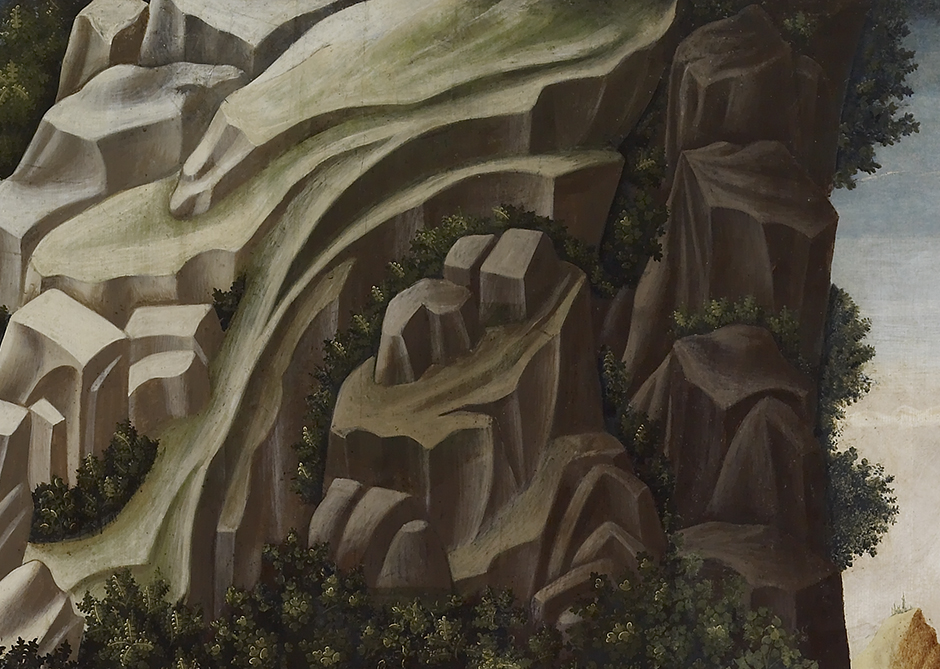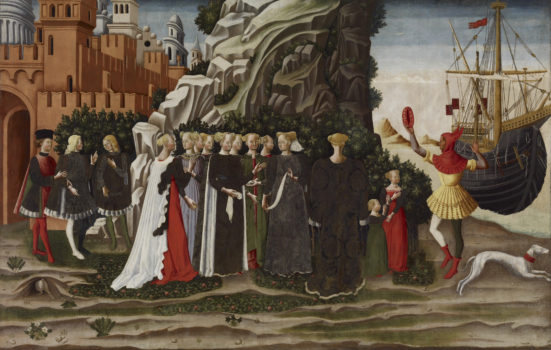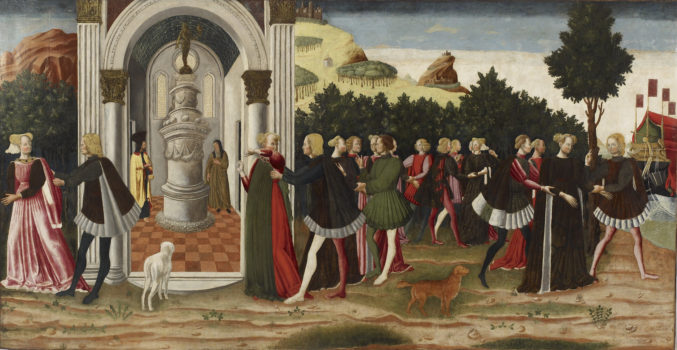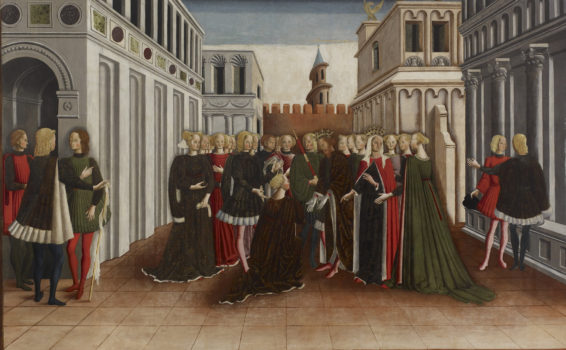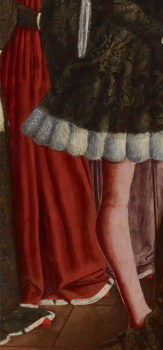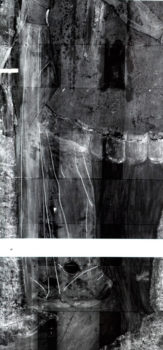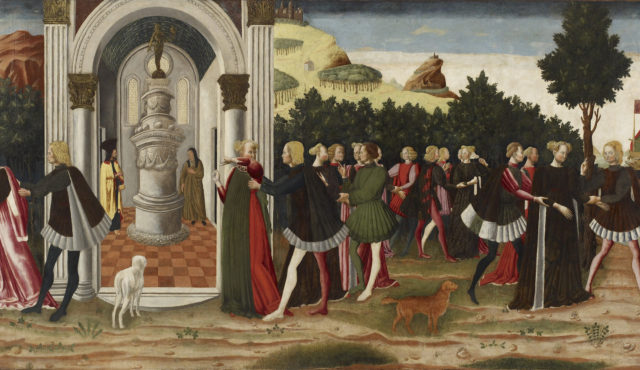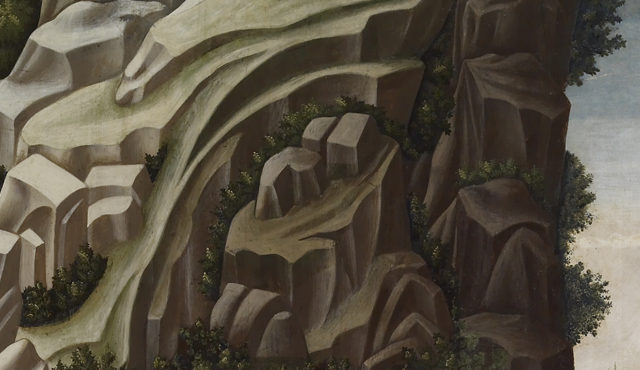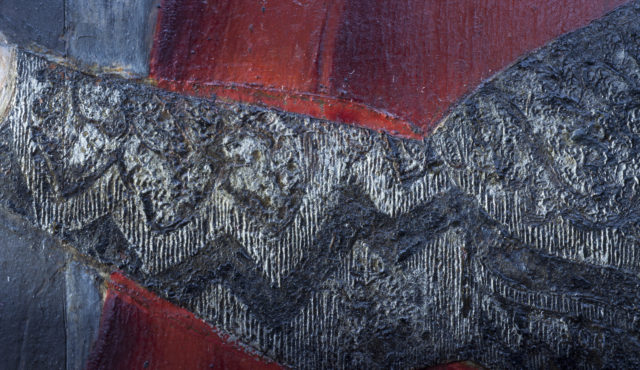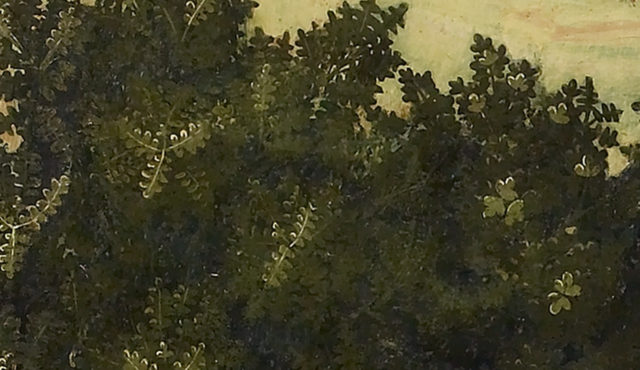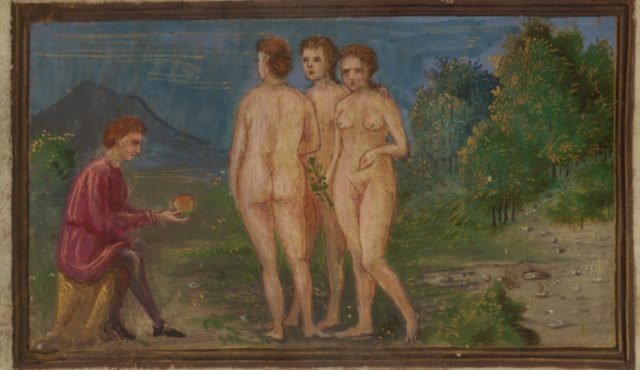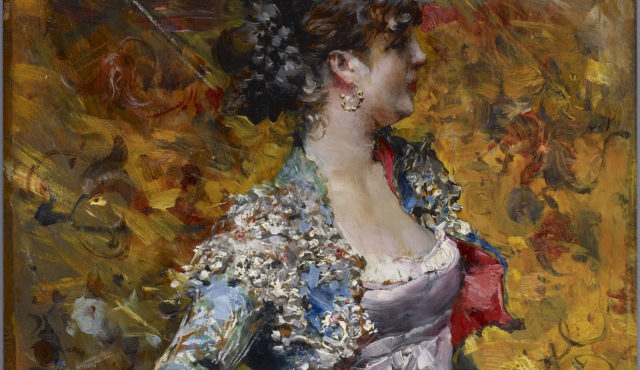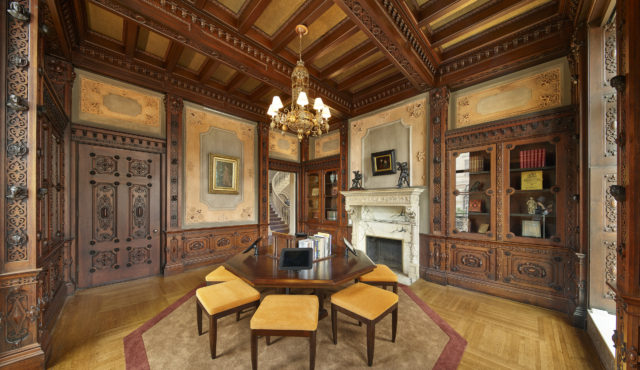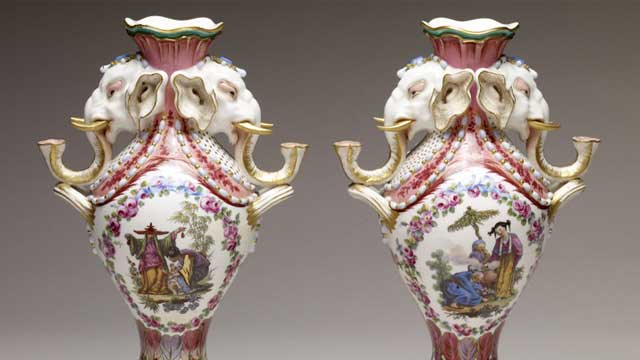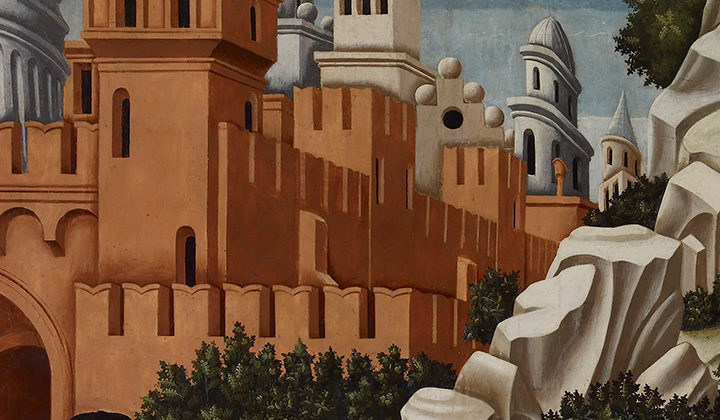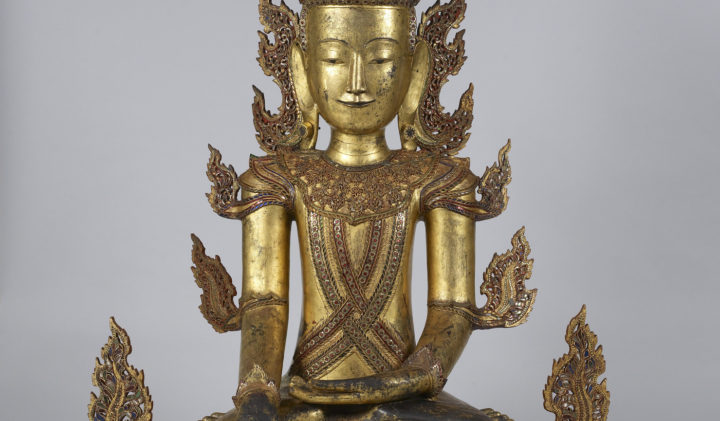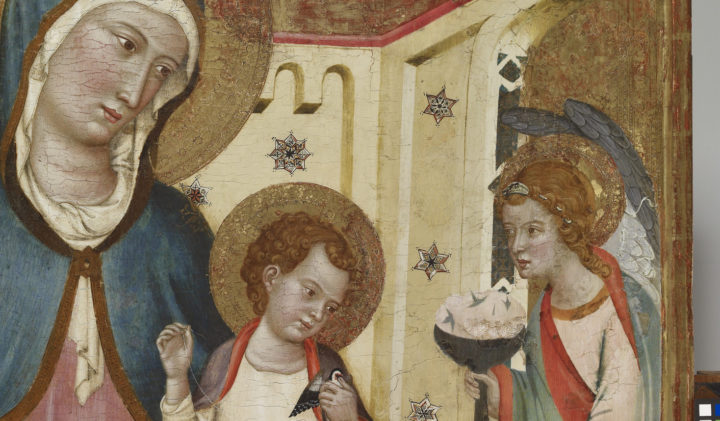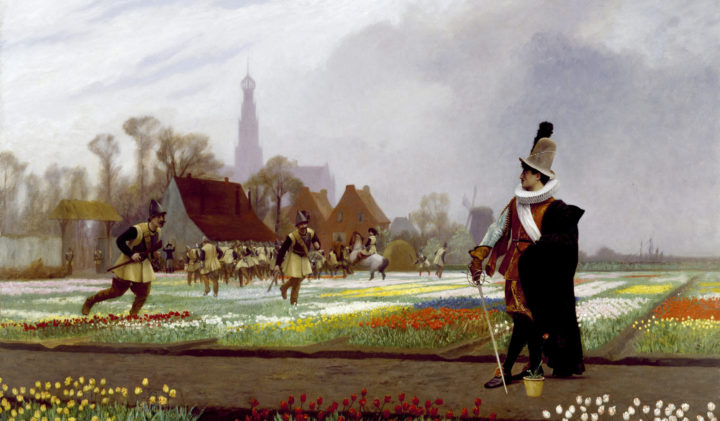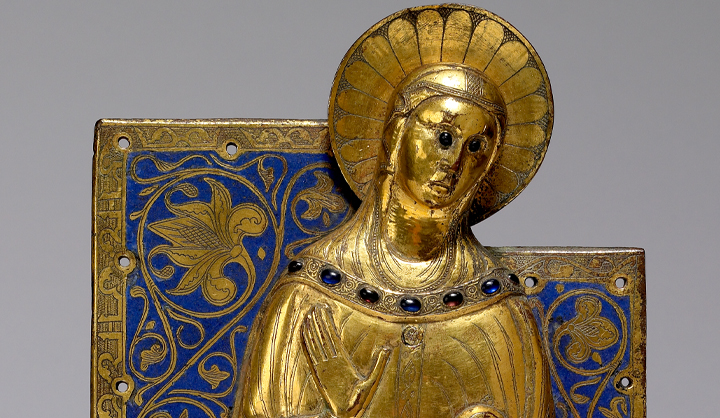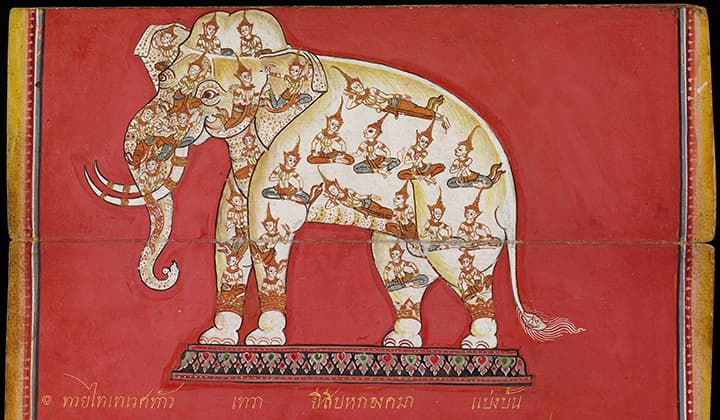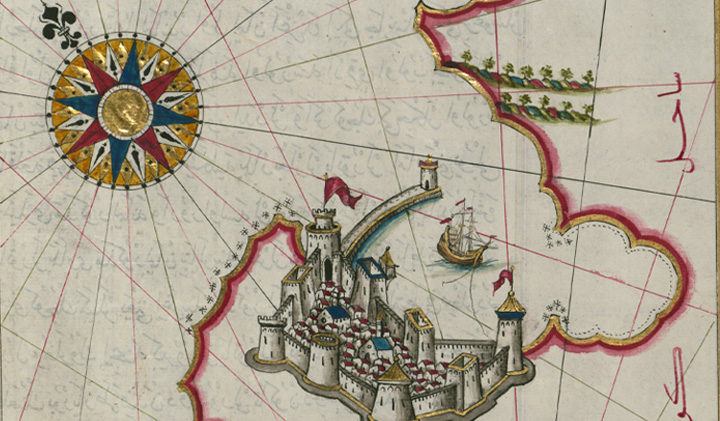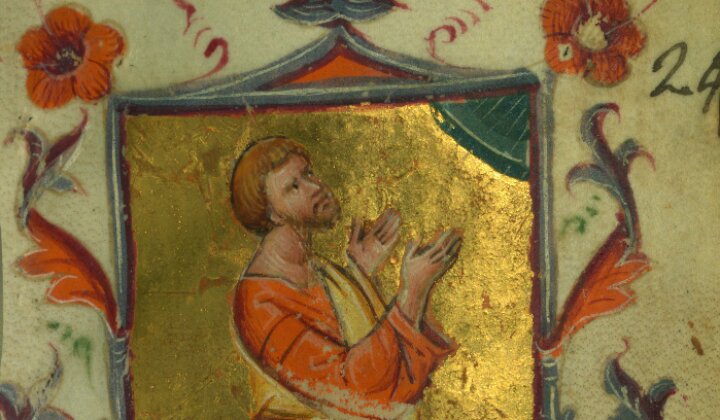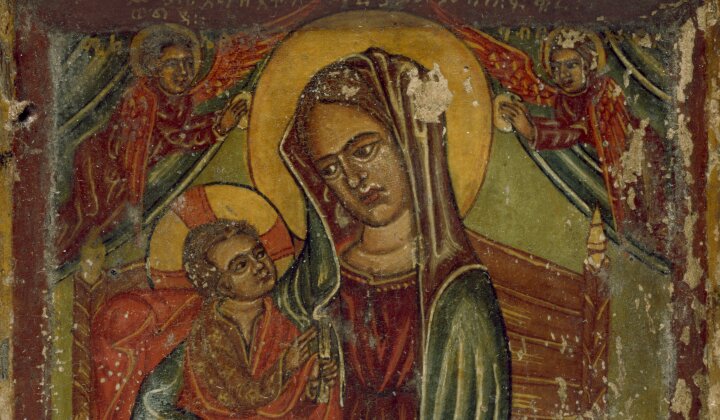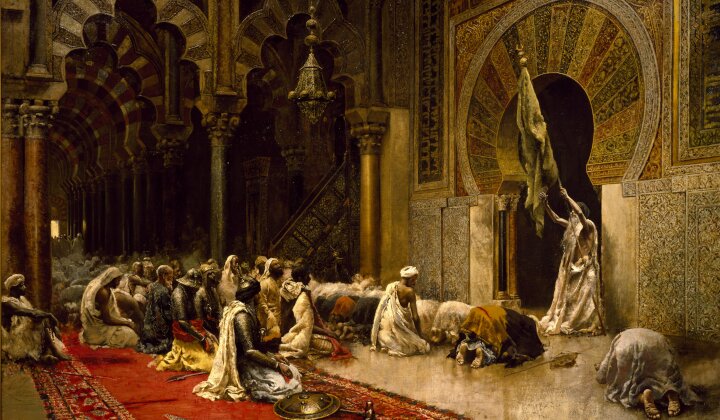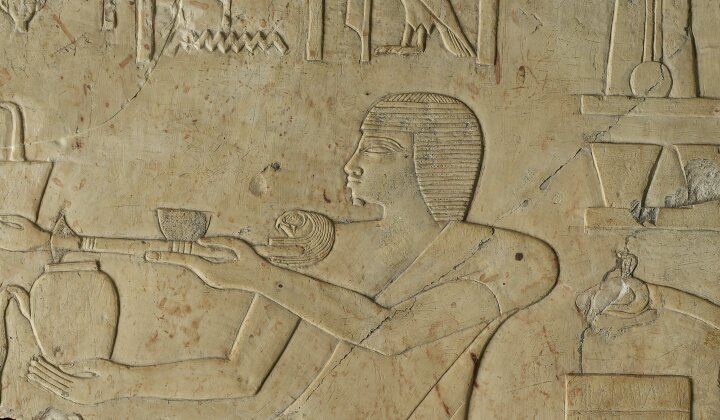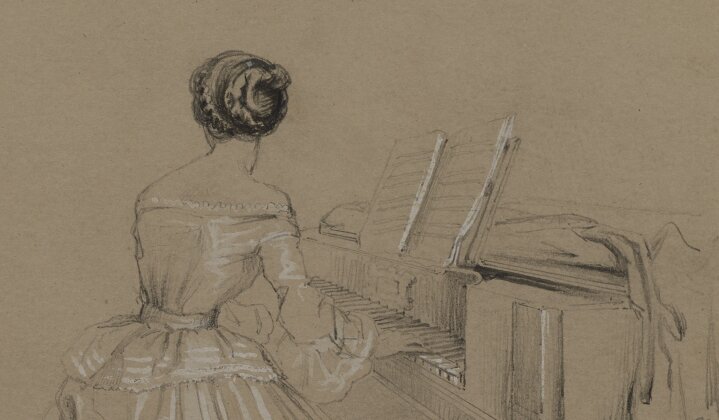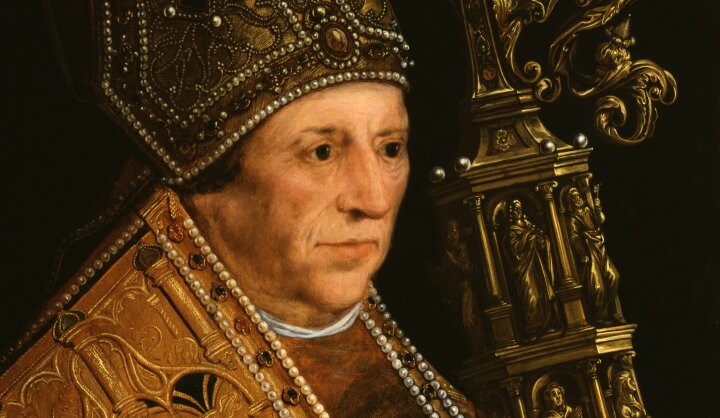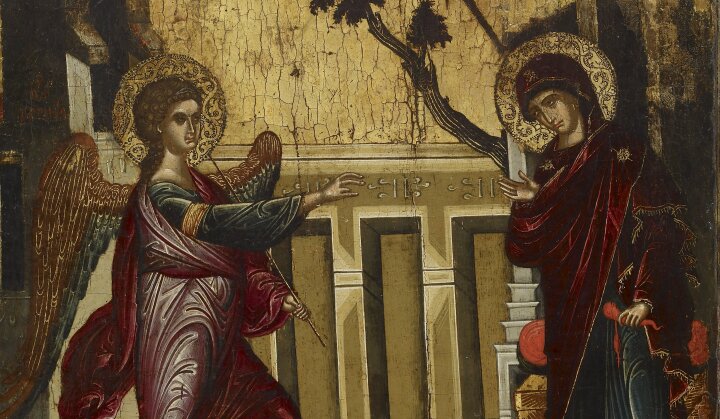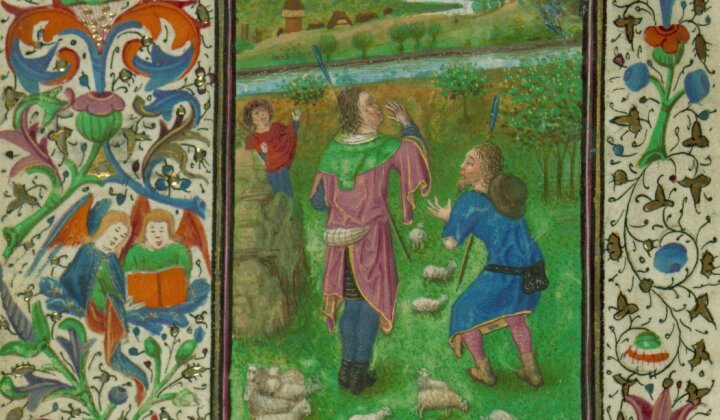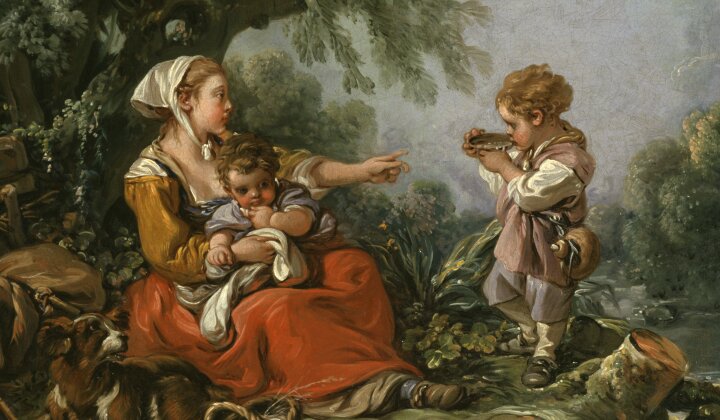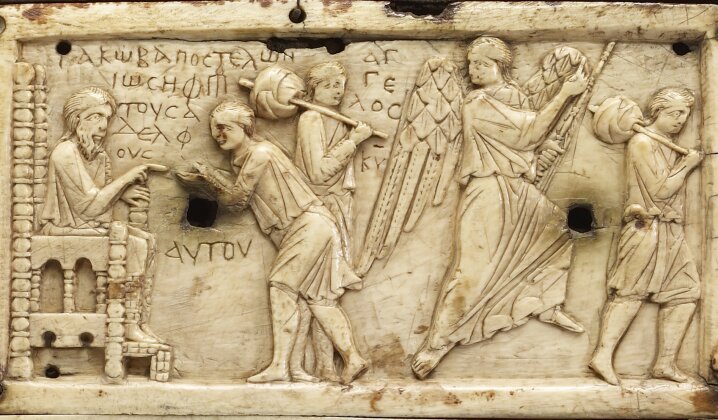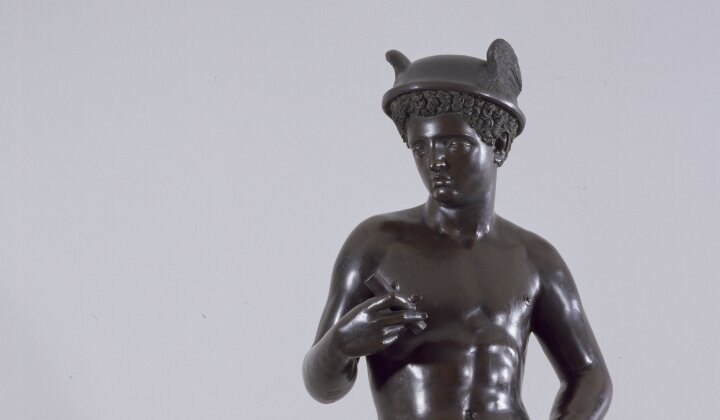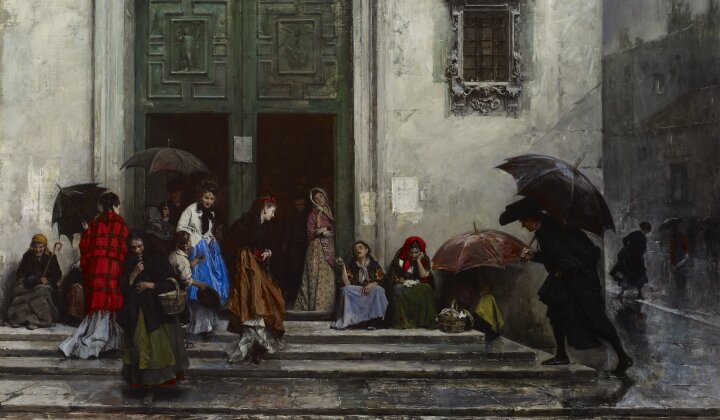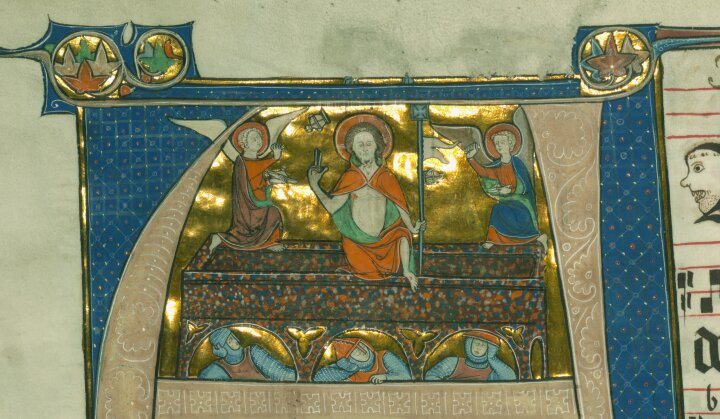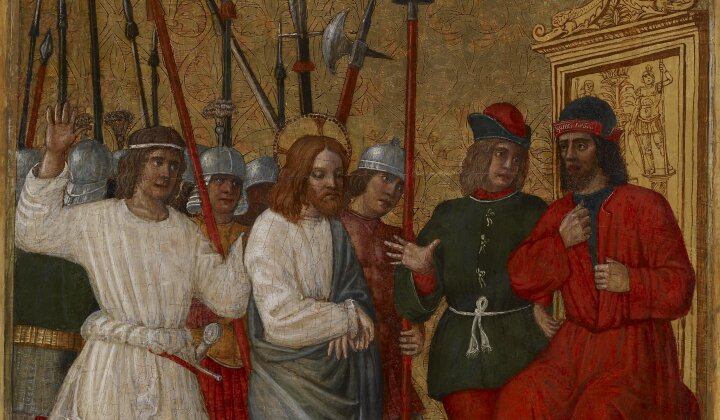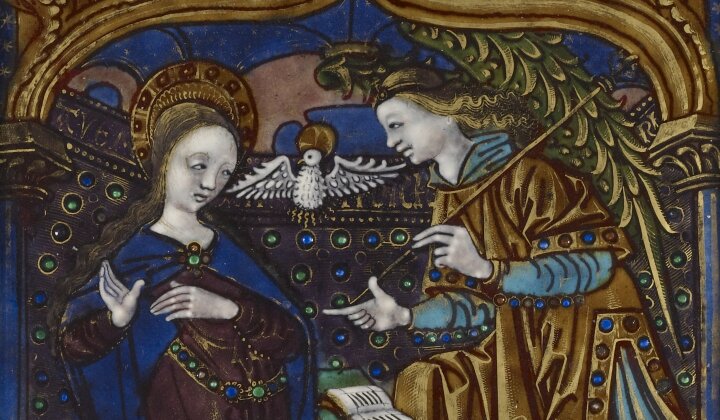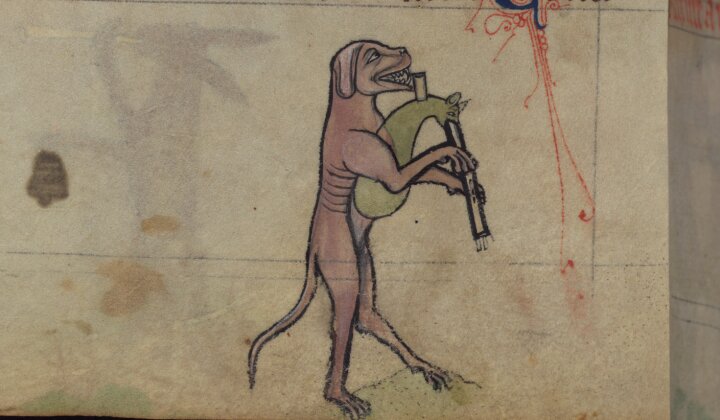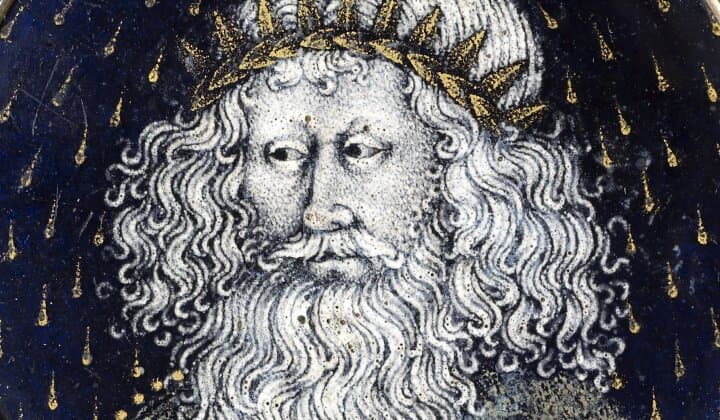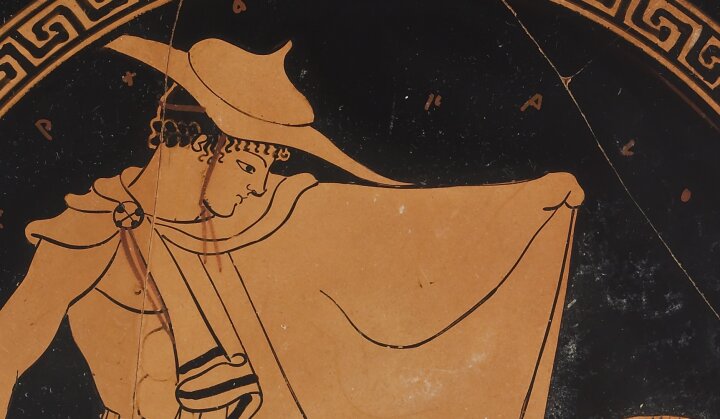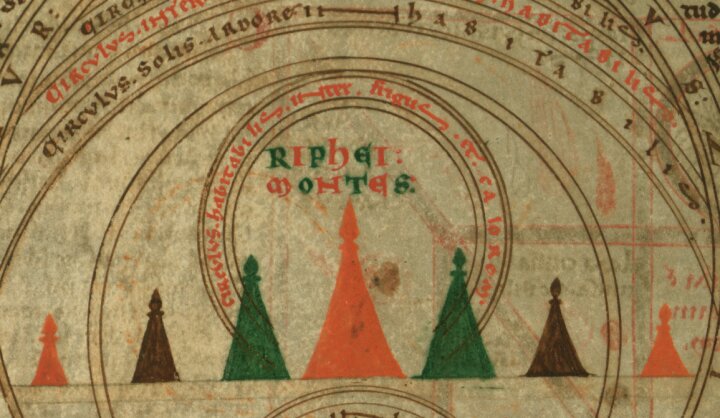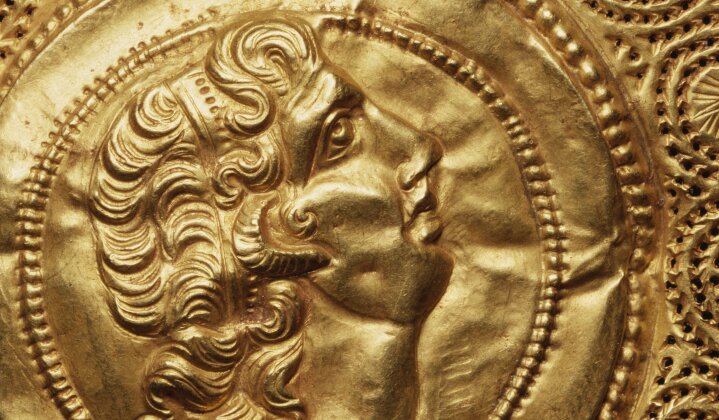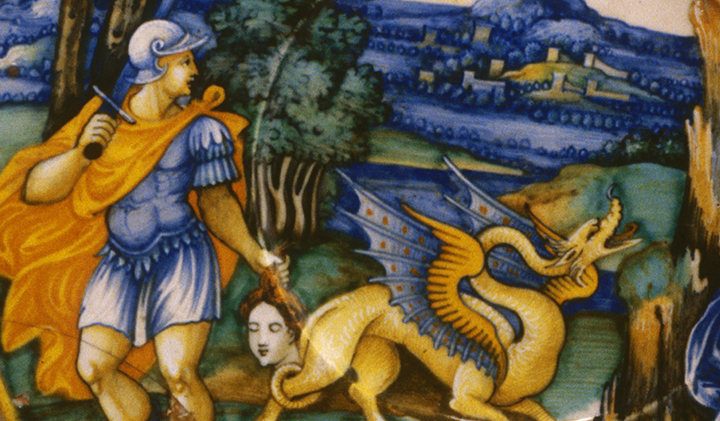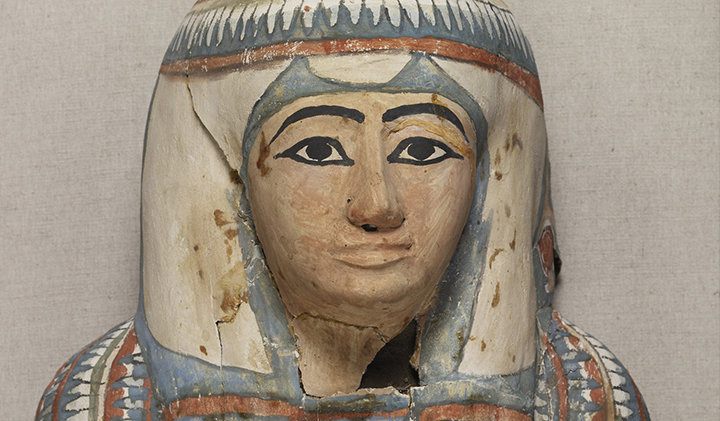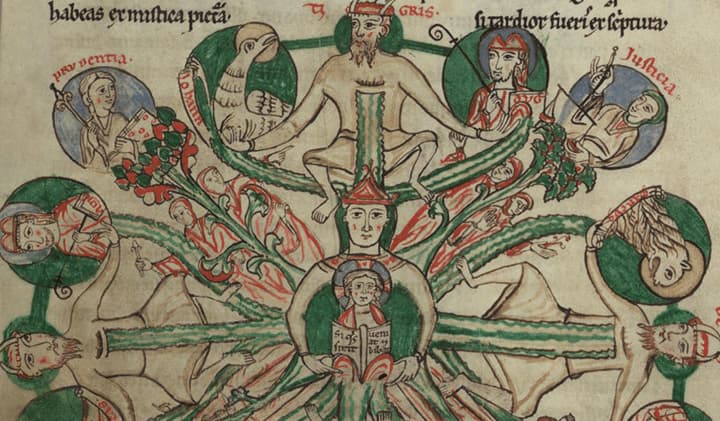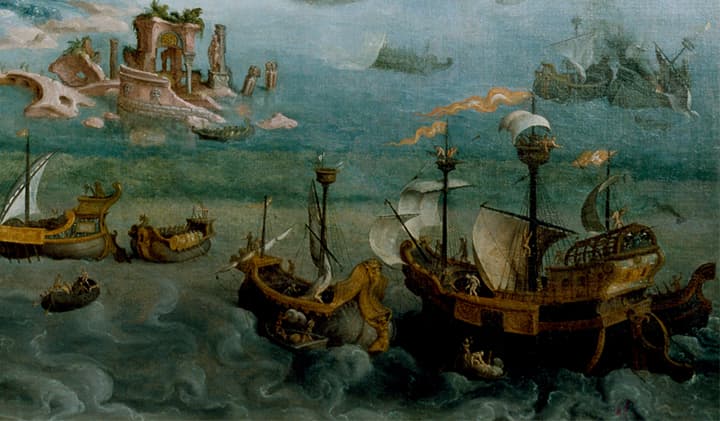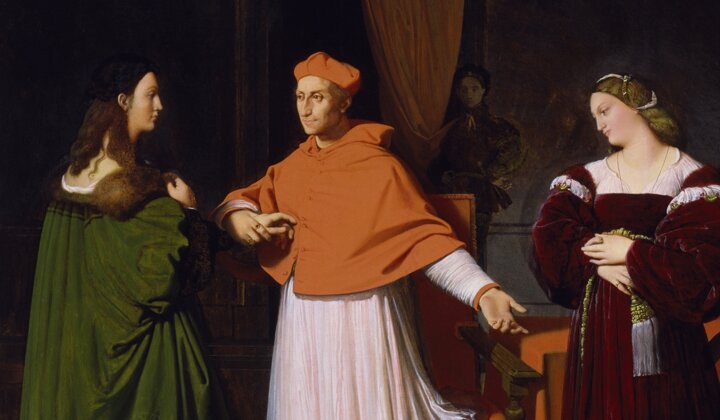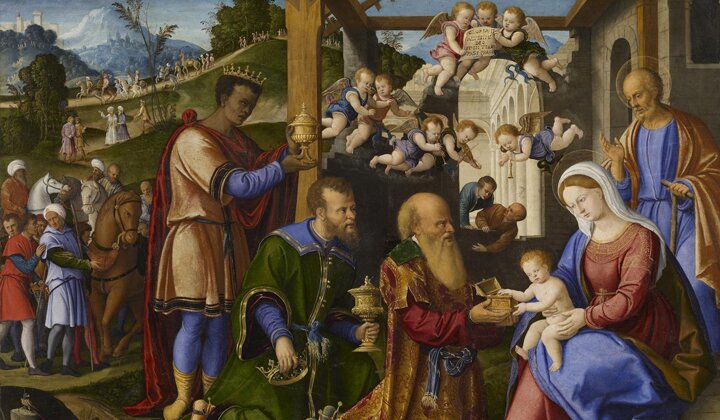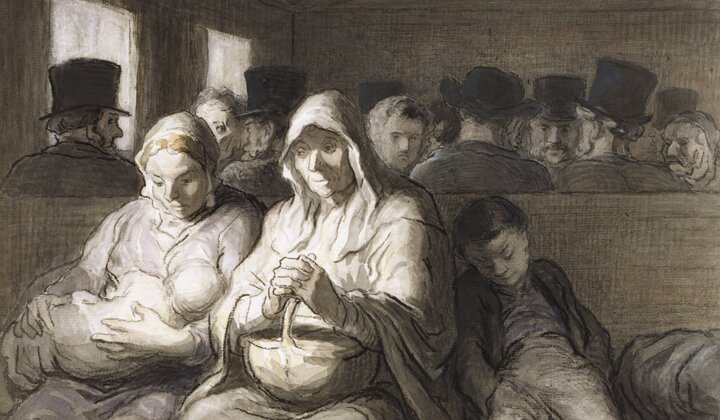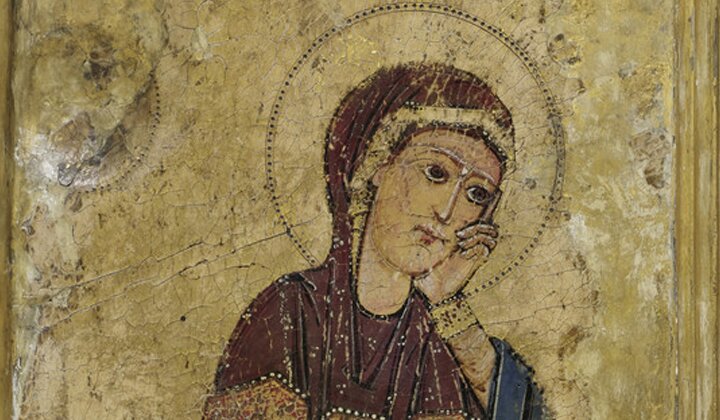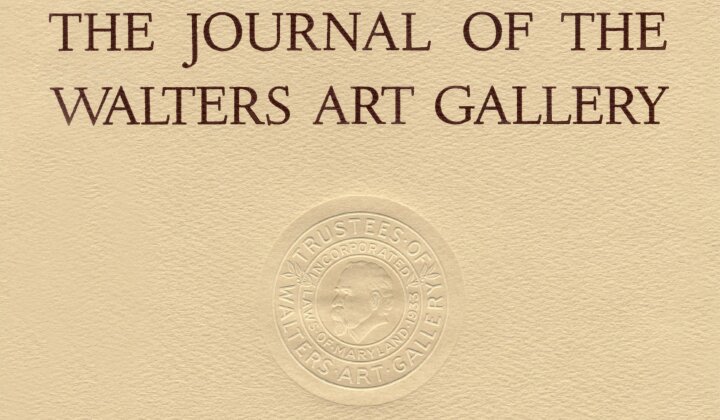Close study of the materials and techniques used in the paintings that compose the Abduction of Helen spalliere—The Departure of Helen and Her Entourage for Cythera, The Abduction of Helen from Cythera, and The Reception of Helen at Troy (fig. 1)—has provided a wealth of information about when, where, and how the paintings were made, as well as their relationship to two other paintings that are believed to have been part of the same commission: Garden Wall with a Trellis of Roses (private collection) and The Garden of Love (National Gallery of Victoria, Melbourne). Research undertaken during the conservation of the Walters paintings between 2010 and 2017 revealed findings about the construction of the wood panel supports, an unusual ground and localized priming layer, a noteworthy use of specific pigments, alterations in the designs, and an extensive use of applied relief brocade, or Pressbrokat (discussed by Pamela Betts and Glenn Gates in a separate essay in this volume).[1]
The Construction of the Panels
The three paintings are on large wood panels that measure approximately five feet high (152 cm) and range in width from eight to nearly ten feet (244–305 cm); the panels’ original thickness is estimated to have been in the region of 1–1½ inches (2.54–3.8 cm). The paintings are known as spalliere, after the Italian word for shoulder (spalla), referring to decorative or painted panels displayed at shoulder height. Often painted as part of a cycle, spalliere are generally rectangular and at least one and a half times as long as they are high, as is the case with the Abduction of Helen series.
Spruce was chosen for the wooden support of the three paintings,
rather than the ubiquitous poplar generally employed throughout Italy.[2] Although spruce can be of high quality, the wood selected for these panels contains many faults, knots, and somewhat twisted grain; the selection might have been driven by considerations of cost or simply by the scarcity of large, fault-free planks. Several studies of panel painting supports have reported that spruce was more often used in northern Italian regions than in peninsular Italy, suggesting that the wood might have been sourced locally in the northern regions of the Veneto area. Spruce is documented as a support in Venetian paintings during the fifteenth century as well as for the construction of furniture in the city and its surroundings,[3] and in the neighboring Tyrol and south German regions.[4] In surveying European panel paintings from the twelfth to the sixteenth century, Jacqueline Marette observed that in “continental Italy, . . . particularly in the north, . . . larch dominates at high altitudes, but spruce is found throughout. Spruce in Italy could, therefore, only have come from the northern region,” and “forest and historical maps allow us to infer the rule that painters exclusively used local wood to construct their panels. This rule is borne out with such rigour that a panel painted on a wood foreign to its region has to be considered an anomaly.”[5]
Though guided by guild regulations, the techniques for constructing Italian wooden supports, while sharing some basic elements, varied according to century and region, the particular commission, and the artists’ studios.[6] The wood grain for painting supports was usually oriented in the direction of the plank’s longest side. The very large and wide panels of the Walters’ paintings were instead constructed of planks of vertical-grained wood “butt joined” together, edge by edge, probably with casein glue, composed of a mixture of cheese and quicklime, as described in Cennini’s guide to painting, Il libro dell’arte, composed around the turn of the fourteenth century.[7] This vertical orientation of the planks might have been intended to mitigate potential aging problems along very long horizontal joins, or because no planks could be found of adequate length for the scale of the commission. Although no evidence of them remains, cross-grain wooden dowels, inserted into prepared holes at the edges of the boards, were probably employed to help align and reinforce the joints.[8]
The number of planks composing each spalliere painting is difficult to discern due to oxidation, damage, and in the case of the Abduction, the addition of wooden strips to all the edges. No original back surfaces remain on the panels because of the drastic and uneven thinning of the wood to accommodate nineteenth-century wooden cradles on the back of all three paintings.[9] Visible evidence of panel joinery or reinforcements has therefore been lost and close examination obscured.
X-radiography helped confirm some of the joints, suggesting that each panel consists of five or six planks, averaging around 19 inches (48 cm) in width (fig. 2).[10] Five planks were identified in the Departure, but the widest of these is probably composed of two boards with a non- distinguishable join. The Abduction has six planks with a 2 3/8 inch-wide (6 cm) section on the far right. The Reception probably has five planks, although only three major joints can be distinguished, along with narrower panels at left and right. Although there had been some attempts during the fifteenth century to standardize the dimensions of planks and panels, significant differences in the widths, heights and thickness of boards even in a single painting support have often been noted.[11]

Overlay schematic of the Departure, the Abduction, and the Reception showing possible positions of original plank joints (marked with red lines), and circular wooden plugs (marked by purple circles)
All three paintings show evidence of being trimmed to various degrees; none retains its original overall dimensions. The panel widths differ (and probably did in their original formats), but they were probably all originally the same height to enable them to be set into wainscoting or paneling; the present heights of all three are within a fraction of an inch (1–3 mm) of one another. The Departure is close to its original width since its unpainted wooden margins are still present on both left and right (fig. 3). There is one unpainted margin at the left edge of the Reception; no unpainted margins or original edges remain on the Abduction.

Detail of bare wood margin at the right edge of the Departure
The removal of knots was a common step in the preparation of panels, since they are weak points when subjected to changes in temperature and humidity. The resulting holes were plugged with an often square wooden insert or sawdust and glue fill.[12] A few small, squarish wooden inserts are visible on the back of all three Walters panels between the sections of the cradles and in x-radiographs. These were probably inserted after removing resinous or loose knots at the time that the panels were prepared, but several knots are still visibly present on the front of the painting and remain unplugged from the reverse.
A series of approximately 1½ inch-wide (3.8 cm) circular wooden plugs spans the upper third section of all three paintings in a meandering horizontal line; the plugs on the Reception reveal the most regular pattern (see fig. 2). There appears to be at least one plug per main plank, and close examination under the microscope, with x-radiography, and infrared reflectography (IRR) confirms the presence of original paint, ground, and drawing on their front surfaces (fig. 4).[13] Where visible from the back, the plugs are darker than the original panel, possibly end grain, and are the same depth as the surrounding wood, having been thinned with the panel for cradling.
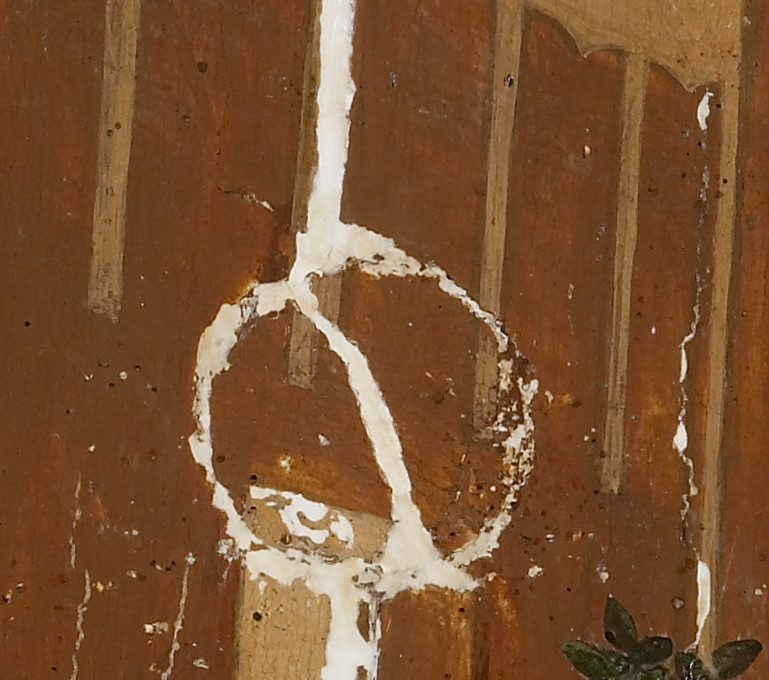
Detail from the Departure of circular wooden plug showing original paint and white gesso fills in old paint losses
Large panels such as these would have required some type of structural reinforcement attached to the reverse. Although the fifteenth century was a transitional period in Italy in the construction of bracing systems for larger panel paintings, the panels were generally reinforced through a type of wooden cross-grain batten system, applied in several spaced rows across the planks. Cross-battens were generally nailed in place, hammered into partially pre-bored holes. The flat nail heads were anchored through one side and the nail points clinched back into the wood on the other side. Often the nail head was on the batten side with the point coming back into the front side of the wood in a pre-gouged area, then filled with a wooden plug (preferably of the same type of wood), isolating the gesso preparation layers from the iron. Sometimes, the nails were inserted with the heads through the front of the panel (slightly countersunk) and the points clinched into the batten from the back; the resulting depressions on the front were subsequently covered with a wooden plug or fill, typically square, prior to application of gesso preparation layers and paint.[14]
The wooden plugs on the Walters panels may be part of the original construction related to the attachment of just such a secondary reinforcement system on the back, but their positioning in one or two roughly horizontal rows only across the upper sections of the paintings makes this origin implausible (see fig. 2). The plugs in the Walters panels are circular, not square, and if not related to battens for strengthening the panels, might be a residue of some original mounting system. Evidence that might have helped explain their function was removed when the panels were excessively thinned in preparation for attaching the cradles.
The construction of the Walters’ series resembles that of a related large panel painting titled The Garden of Love in the National Gallery of Victoria, Melbourne (fig. 5). Currently very close in size to the Reception and painted on spruce, the Garden is composed of five vertical planks butt-joined and glued together.[15] It has similar circular wooden plugs in the upper half of the panel, described in the painting’s 1993 examination notes as “a series of button in-fills.”[16] When a diagram showing the positions of the Garden’s plugs is reversed horizontally, the layout lines up almost exactly with the positions of the plugs on the Reception (fig. 5). This correlation indicates that these two panels were probably prepared by the same studio, as part of the same commission, with similar reinforcement batten or mounting systems that necessitated the wooden plugs.
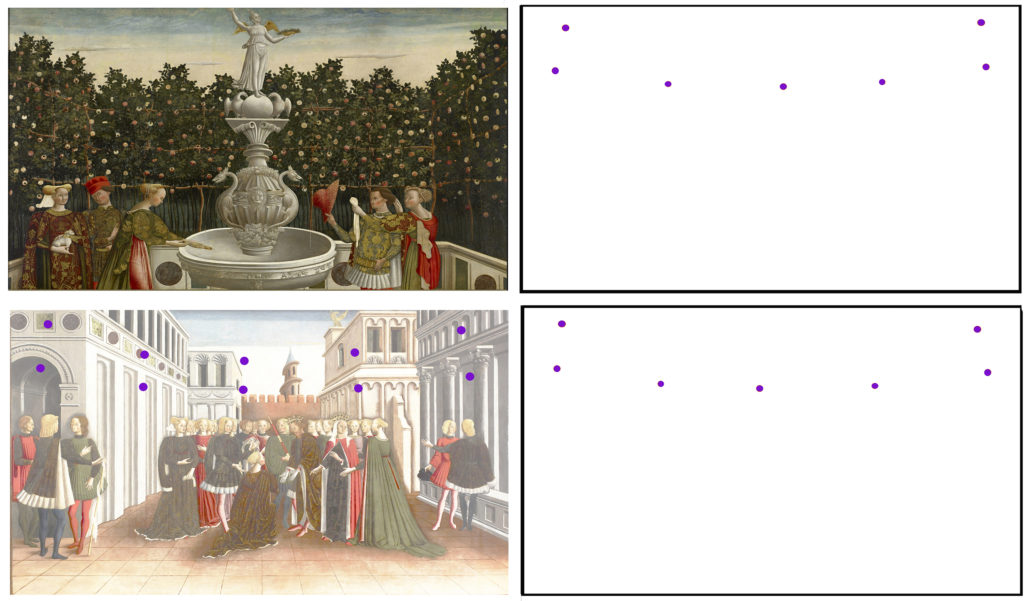
Top left: The Garden of Love (National Gallery of Victoria, Melbourne); top right: position of plugs in The Garden of Love (adapted from a drawing by John Payne); bottom right: location of plugs in Garden of Love reversed horizontally; bottom left: the Reception, showing position of plugs
Preparation Layers
The wood panels were sealed on the front surface with a thin layer of sizing—in this instance probably animal glue—before the application of two distinct layers of ground consisting of calcium sulfate gesso in a proteinaceous binder, probably also an animal glue.[17] The ground has traces of iron, aluminum, and silica, likely from associated clays, with the proportion of aluminum higher in the lower layer than in the upper ground layer.[18] Combined, the ground layers are approximately 175 microns thick, the bottom layer a little thicker than the top.[19] Scanning electron microscopy / energy dispersive x-ray spectroscopy (SEM-EDS) back-scattered electron images of two cross-section samples revealed that the thicker lower layer exhibits particles with a small needle- or rod-like morphology, whereas the top layer has a mixture of sizes of larger, rounded particles (fig. 6).[20] This seems to indicate that a layer resembling fine gesso (gesso sottile), processed to yield fine particles of calcium sulfate dihydrate, was applied first, before a coarser ground of calcium sulfate anhydrite (gesso grosso) was applied above, counter to the manner in which ground layers in Italian paintings of this time are usually prepared. Why the more finely prepared ground layer was applied as the lower layer is a matter for speculation.[21] The wooden plugs in the panel appear to have been in place when ground layers were applied, since there is both preliminary drawing as well as original paint over the plugs.
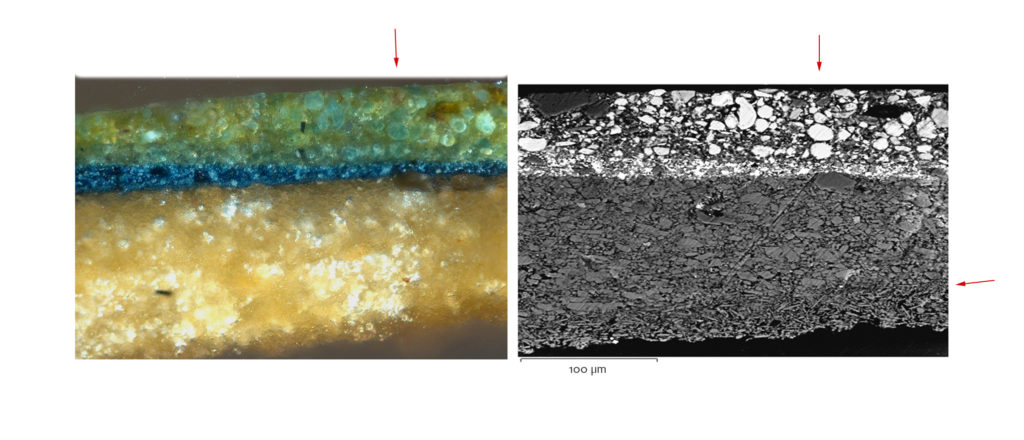
Cross section 2A, from foliage area in the Abduction, in visible light at left and the same area at right in a SEM-EDS backscattered electron image. From top to bottom: thick (green) layer that includes spherical particles of malachite (a corresponding pair denoted by arrow), a thin layer of indigo with calcium and lead white, and a thick upper layer of ground with coarse particles, and remnants of a lower layer of ground with finer needle-shaped particles (boundary denoted by arrow)
Examination detected no overall imprimatura or toning layer on the ground but found several instances of what may be described as localized priming. In the Abduction, the statue of Venus and the ornate capitals that adorn the temple were first prepared for gilding with a thin white paint layer with a low percentage of black pigment applied over the ground.[22] The subsequent gold layers were adhered with a mordant, or glue, often containing a mixture of oil (as in these instances) and resin used for gilding that was not intended to be burnished. Optical microscopy of a cross section from a gilded area identified an interlayer with fluorescence characteristics consistent with that of oil, although the mordant was not further analyzed. A similar thin white layer was also found between the ground and the oil-based fill mass under the molded tin of the Pressbrokat, used to imitate brocaded silk velvet garments on many of the figures (see Betts and Gates, “Dressed in Tin,” in this volume).[23] These findings indicate that a localized thin layer of paint, possibly in an egg tempera binder, was applied to seal the ground to reduce the absorption of oil media in areas of mordant gilding or applied relief (fig. 7). [24] The artists evidently understood that these applied layers posed a risk of detaching had the oil components used to adhere them been absorbed into the ground.

Cross-section samples from the gilded area in capital from the Abduction showing layers (bottom to top). Left: 1. Thick ground; 2. Thin white layer with sporadic black particles (localized priming?); 3. Media-rich layer (possibly oil-resin mordant); 4. Remant of thin gold leaf at far right (possibly original).
5. Multiple layers of metallic and organic restoration material. Right: Area of Pressbrokat: 1. Ground; 2 thin white layer with sporadic black particles (possibly a priming); 3. Thick oil fill mass with resin and red lead particles; 4. Amorphous layer of tin oxide.
Fifteenth-century Italian artists usually sketched out the design for the painting as underdrawing on the ground layers before applying the paint. Infrared reflectography—a technique that uses the near infrared to examine layers below the visible surface of a painting—revealed the presence of underdrawing in the figure’s faces and hands, contours of bodies, legs and feet, architecture, and areas of the landscape, including the large central rock formation of the Departure.[25] Most of the preparatory designs were applied with a brush over the ground layers using carbon-based pigments in a liquid medium. Drips in the drawing defining a woman’s hairstyle in the Departure indicate the fluidity of the liquid medium and perhaps the speed of the application (fig. 8). The drawing appears to have been done in more than one campaign, and possibly by more than one hand, as some features have been heavily reinforced with dark, bold strokes. In addition, a few lighter and finer lines indicate that a dry medium such as charcoal might also have been used, supporting the presumption that more than one hand produced the final underdrawing. Examination detected no evidence that designs had been transferred from drawings or that templates were used, even though many of the figures appear nearly identical.
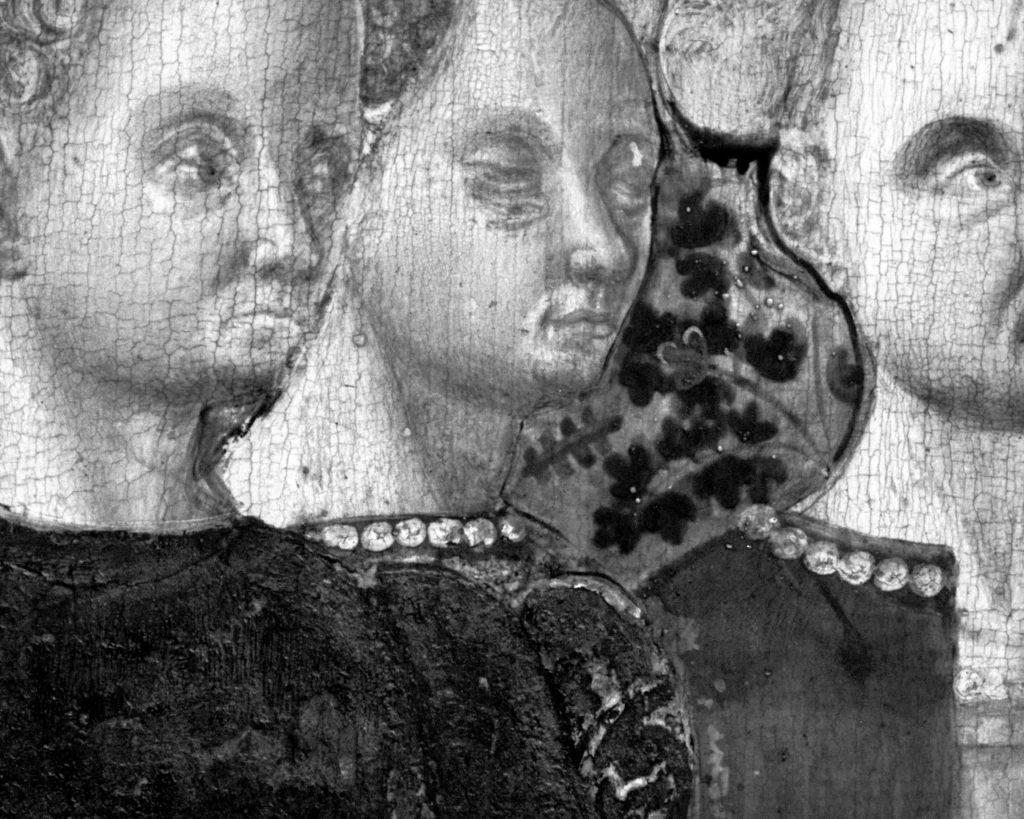
Detail from the Departure showing changes in features and drips in the reinforced lines of drawing media along bottom of hair of the figure at right
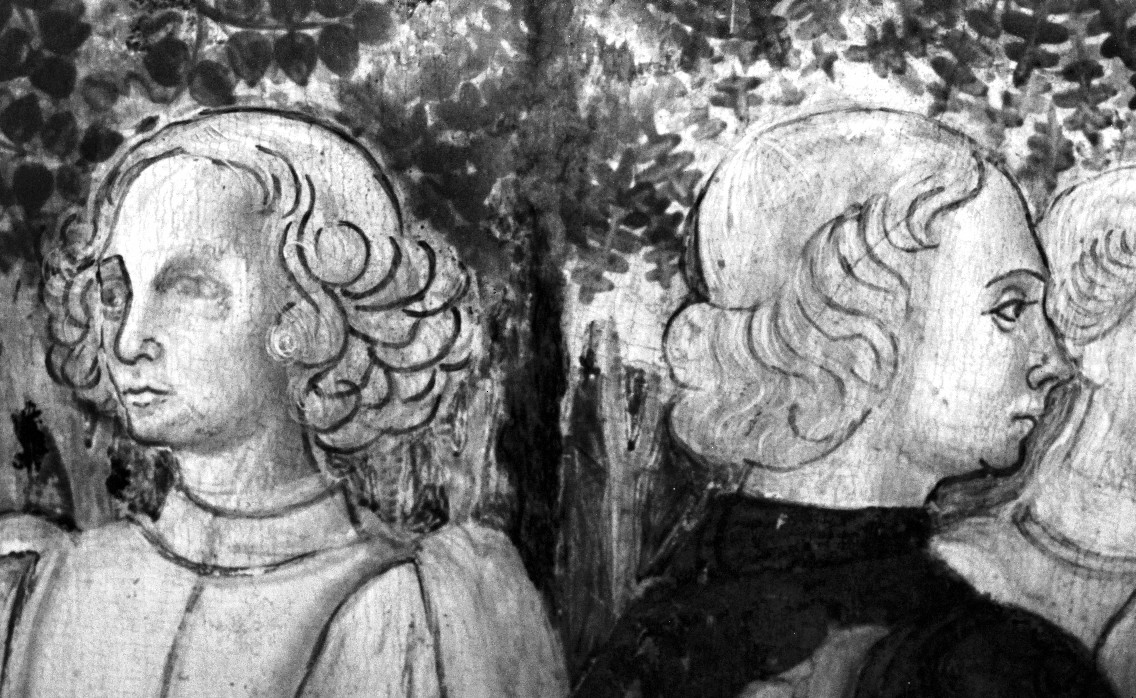
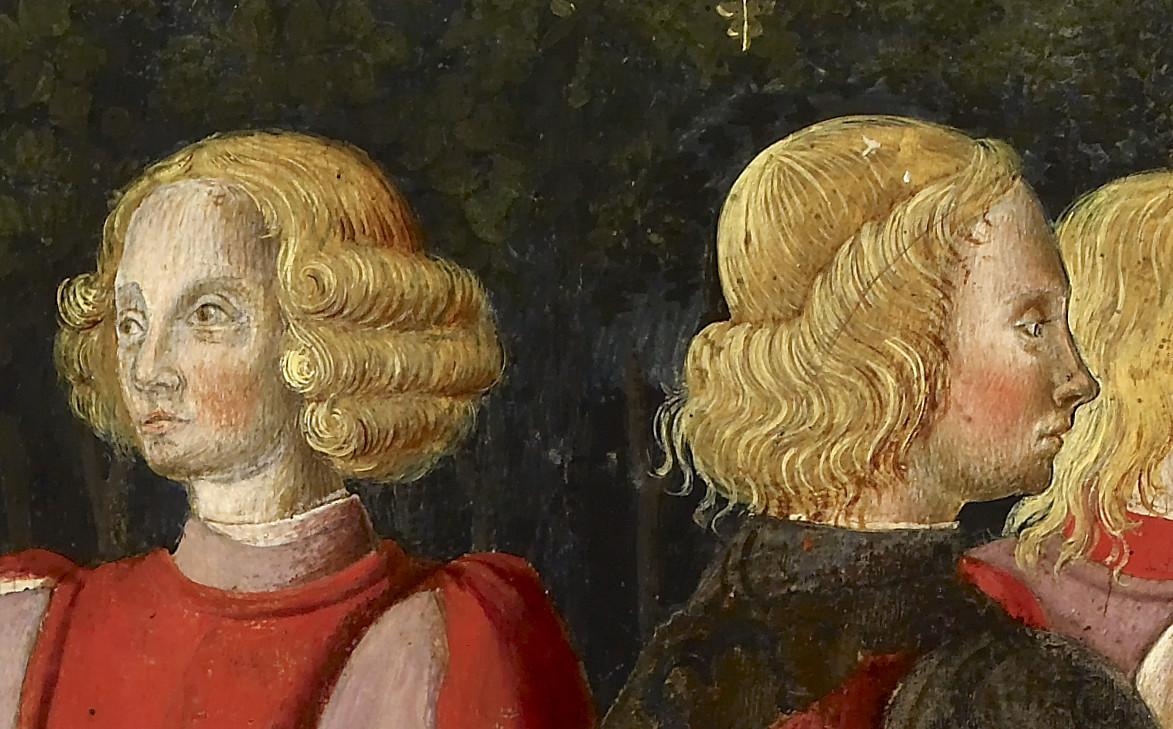
Detail of darker delineations over earlier drawing in the Abduction
The designs were sometimes blocked in with rudimentary shapes that were refined in later stages. For example, the faces of figures in profile or turned away from the viewer were laid in with a simple oval shape over which features were defined later (fig. 10). Architecture was also sometimes blocked in with the most basic geometric forms and subsequently elaborated. In a few isolated areas, narrowly spaced parallel lines, known as hatching, were laid in a seemingly perfunctory manner to indicate shadows in otherwise ambiguous areas of overlapping forms or to define adjacent planes of light and dark in the architecture. These hatching strokes appear to be consistently diagonal, oriented right at top and left at bottom.
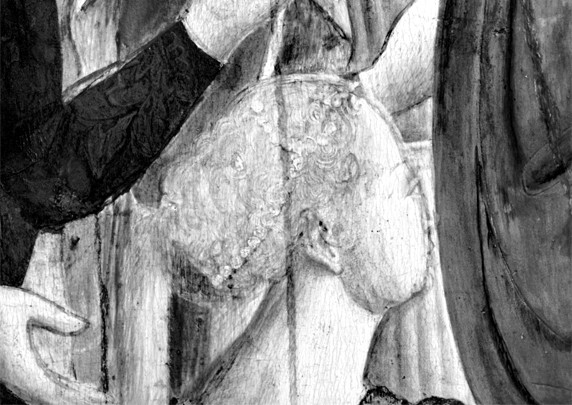
Detail from the Reception showing a simple oval used to initially block in the form of a face
Many changes, or pentimenti, were made during the preliminary design. The artists made small adjustments in the positioning of the figures’ facial features (see fig. 8), necklines, head and hair adornments, as well as to extremities such as legs and fingers. Several drawn details were not included in the finished paintings; in the Reception, a face drawn behind the man with a raised sword was never painted (fig. 11), a long curling mustache was drawn but not painted on the male figure to the left of Paris (fig. 12), and a band was drawn on the forehead of a female figure, possibly for a piece of jewelry resembling a ferronière: a band with a pendant jewel in the middle that encircled the forehead (fig. 13). A cap or band on the head of a male figure in the Departure was drawn but never realized, and various details of the dog in the same painting were drawn in but omitted in the painting stage. The original sketched version was closer to the dog featured in the right foreground of The Adoration of the Magi in the Staatliche Museen, Berlin, by the Venetian painters Antonio Vivarini and Giovanni d’Alemagna, with whose workshop Dario di Giovanni was associated (fig. 14).

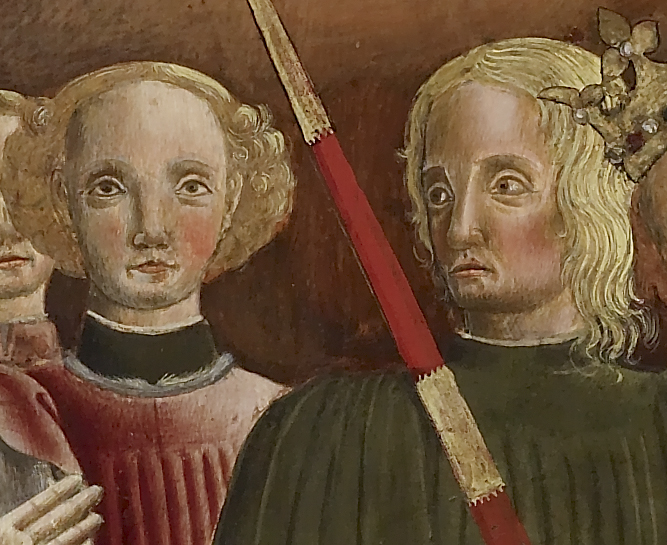
Fig. 11
Detail from the Reception, under visible light and under IRR, showing an additional figure not realized in the finished painting
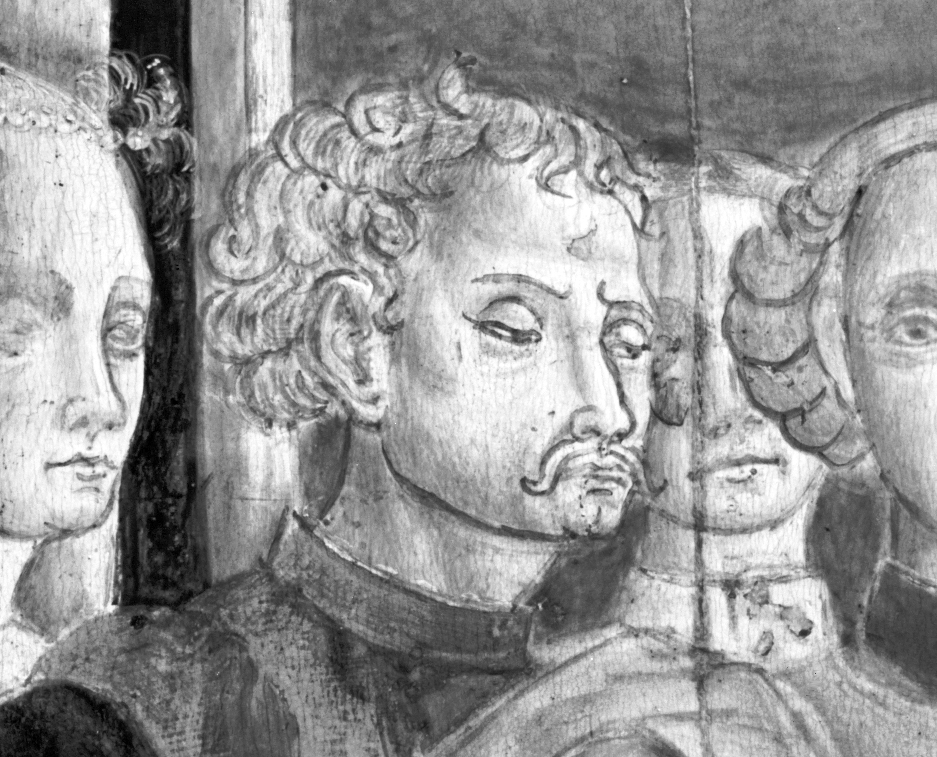
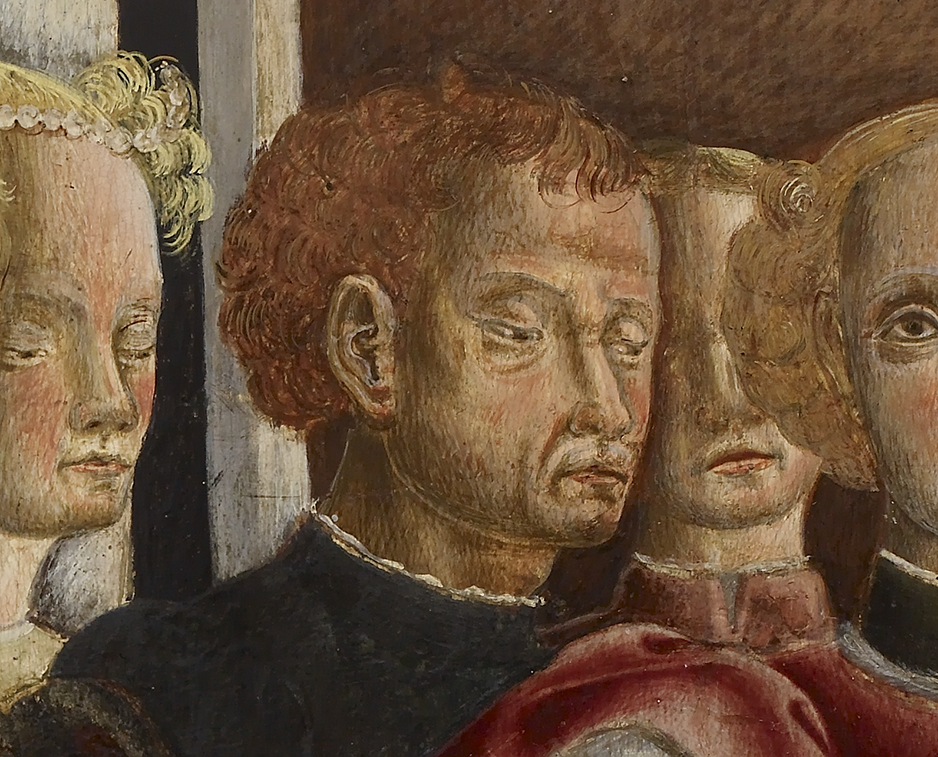
Fig. 12
Detail from the Reception, under visible light and under IRR, showing a mustache on one of the male figures, not realized in the finished painting
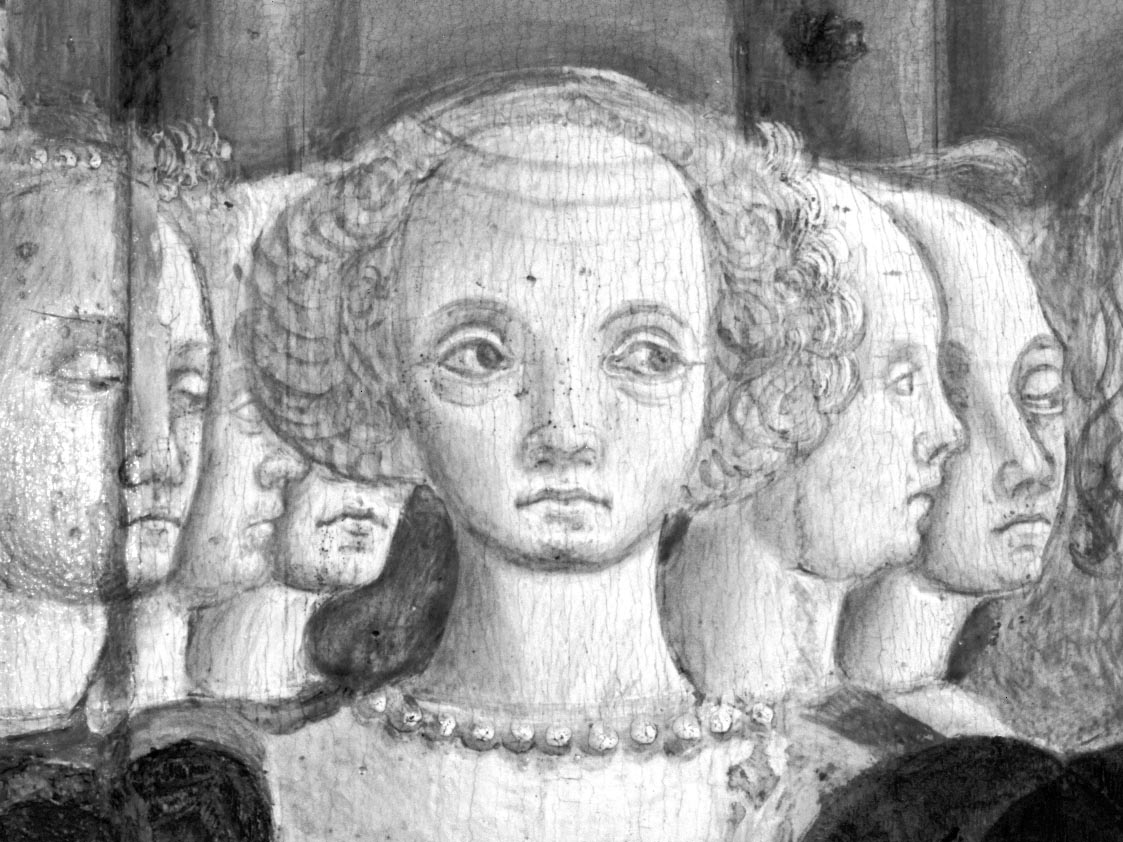
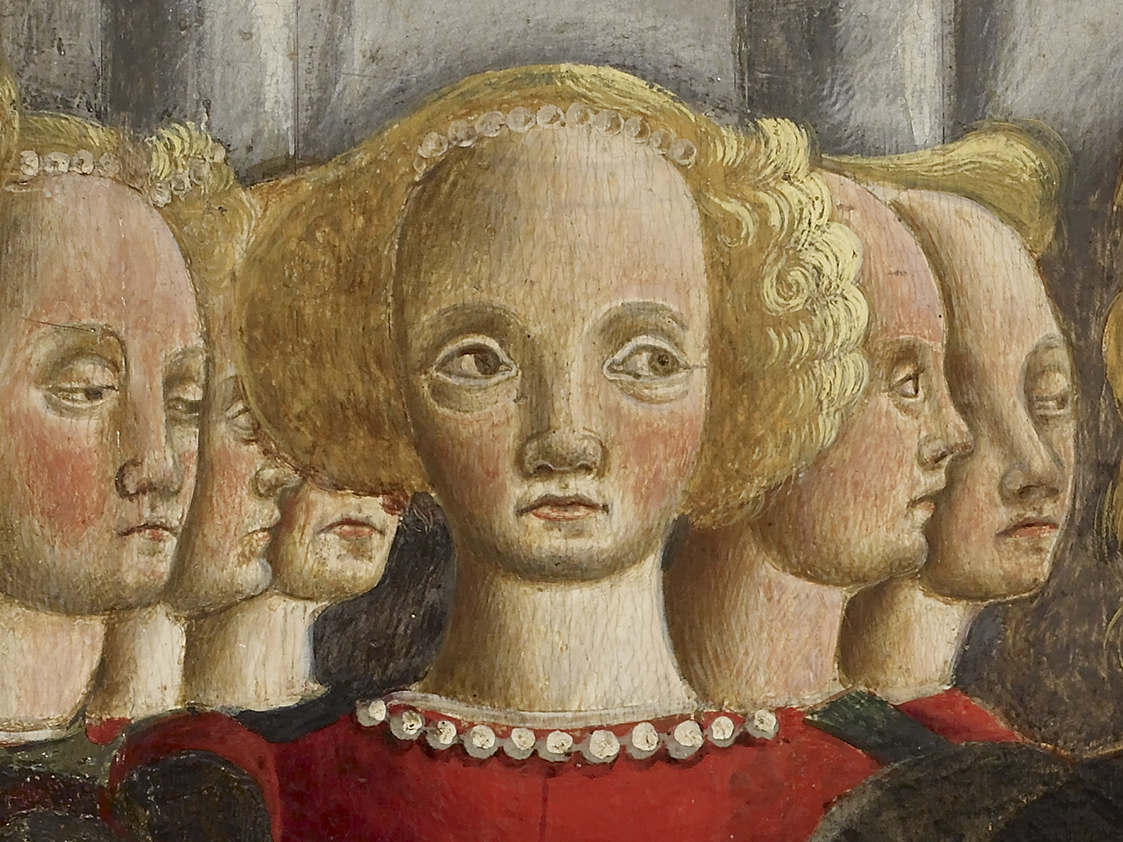
Fig. 13
Detail from the Reception, under visible light and under IRR, showing a ferronière not realized in the finished painting

Left: detail of a dog from the Departure under visible light; center: under IRR; right: detail of dog (reversed horizontally) from Antonio Vivarini and Giovanni d’Alemagna, The Adoration of the Magi, Gemäldegälerie, Berlin
Several structures in the Abduction were either moved or completely eliminated. A castle, sketched in the landscape to the right of the temple of Venus, was moved upward, to appear seemingly farther in the distance. Another large castle was initially positioned between the temple and the central hill to the right but omitted from the final design (fig. 15). At the base of the central hill, the painted castle was initially planned with a slightly larger form on a mountain with a different contour line. Small houses were originally sketched among the mass of trees at center, presumably to accompany the single house that was realized in paint. In the Reception, the individual beadlike forms of the ornament along the arch at left were drawn twice, repositioned slightly lower than first planned (fig. 16). The size, shape, and position of the porphyry roundels above and to the right of this arch were also altered.
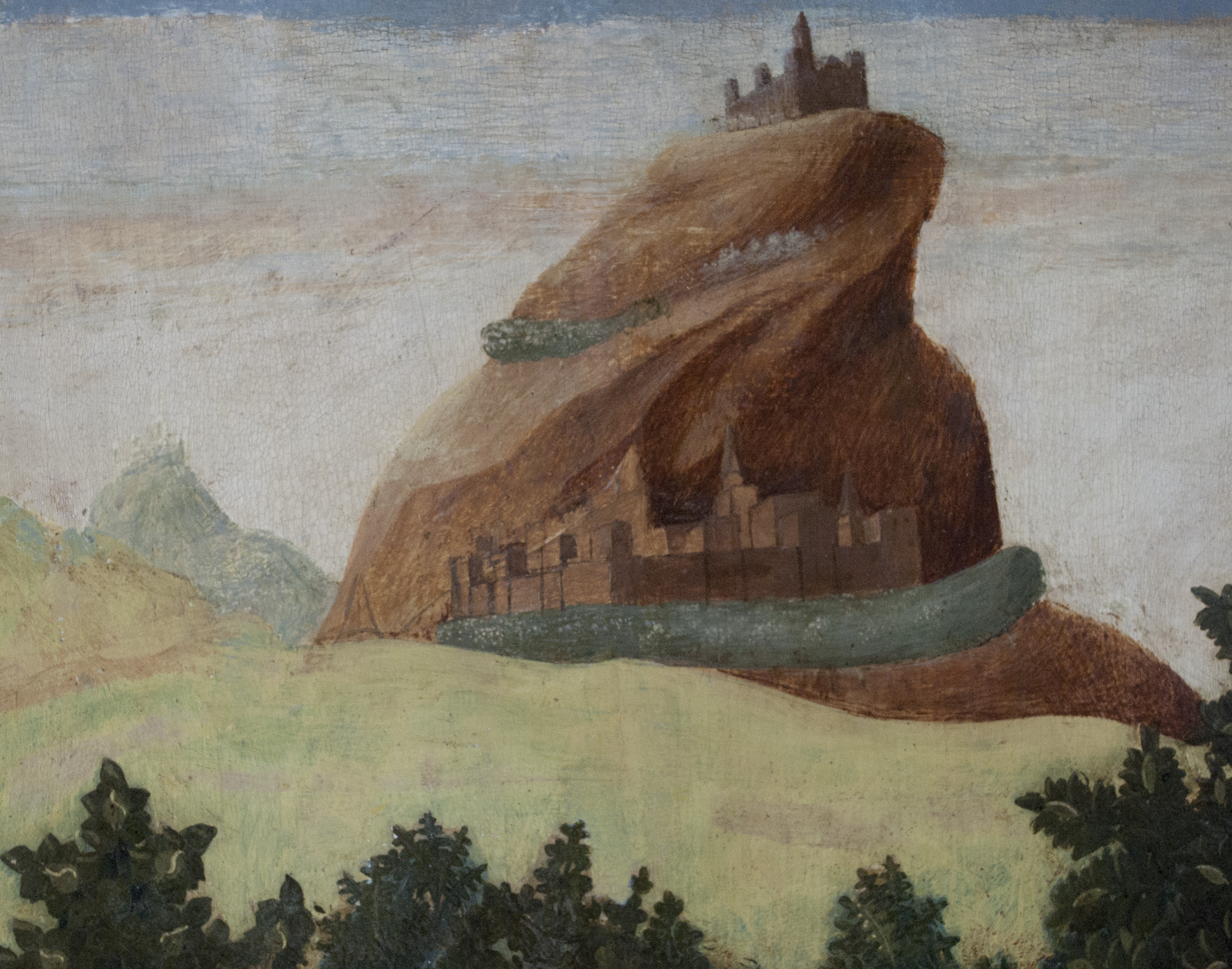
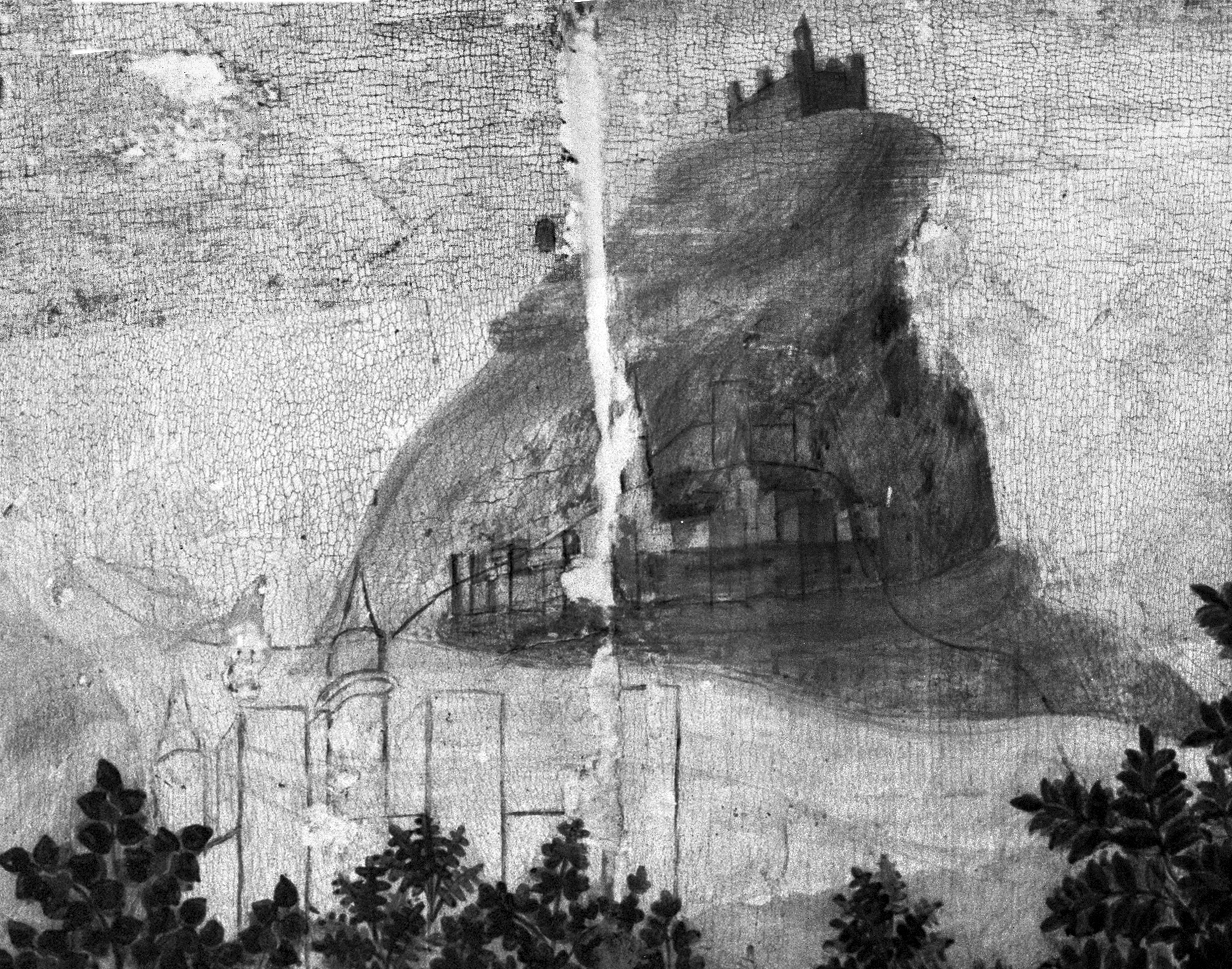
Modifications to the landscape in the Abduction under visible light and under infrared; the white vertical area on the infrared light is an area of loss to original paint layers along a join in the panel.
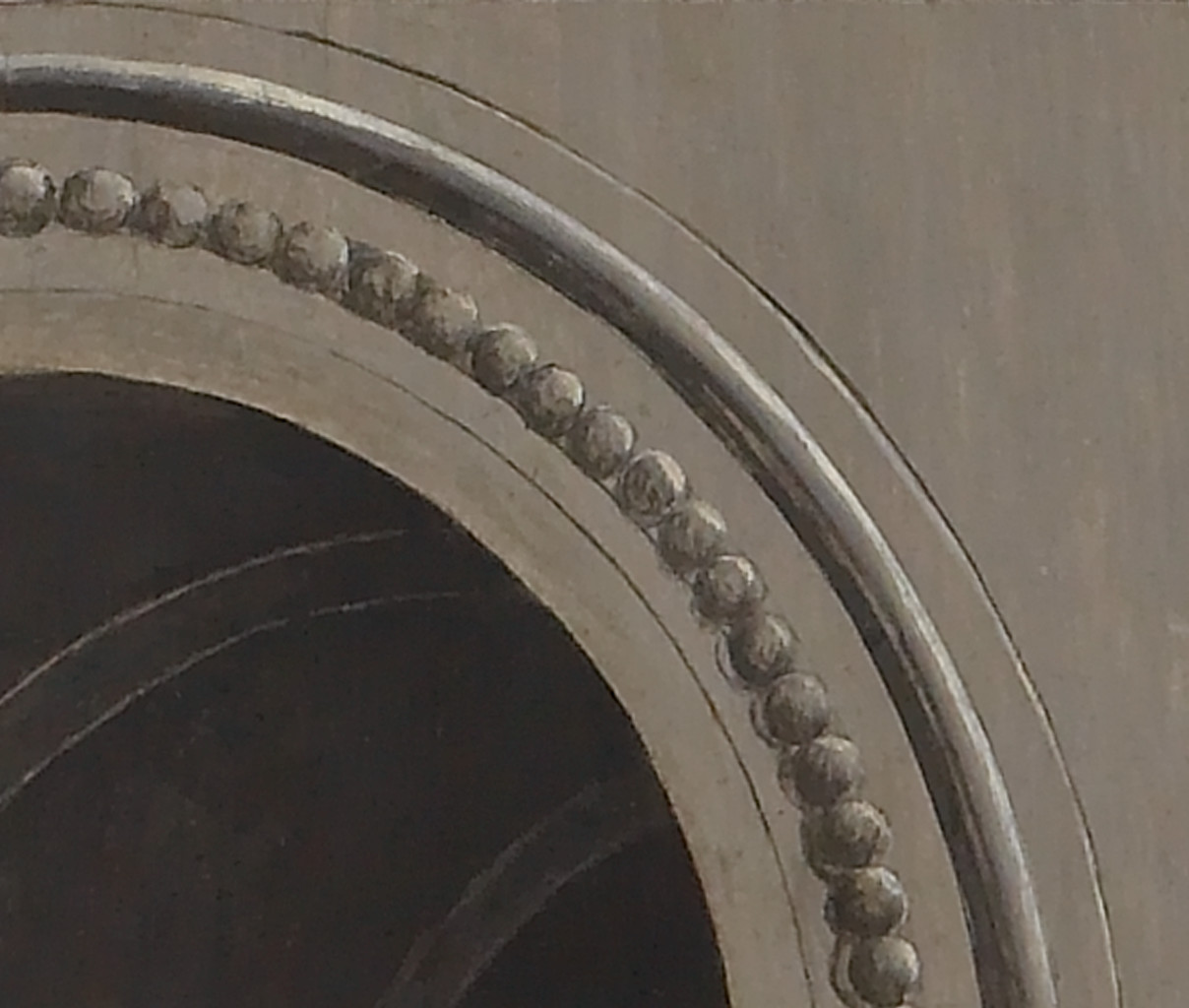
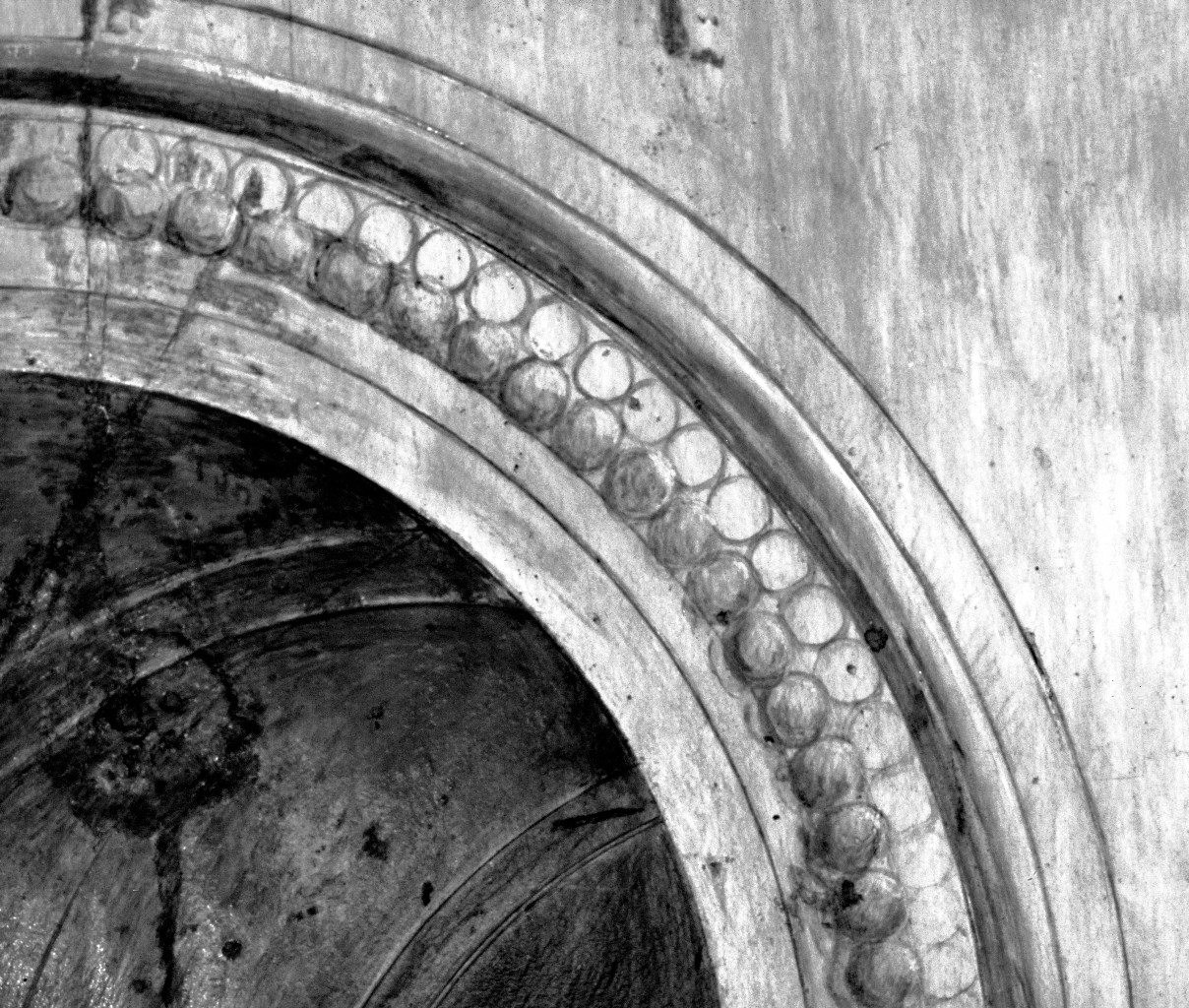
IRR detail from the Reception showing the repositioning of the bead ornament over the arch at left and subtle hatching marks along the outer molding
The most radical and extensive alteration to the composition was to the ship and surrounding landscape in the Departure. Preliminary examination with IRR revealed an adjustment to the position of the larger of the two mountains in the distant horizon by the jester’s raised right hand, and suggested a form in the sky that was at first interpreted as the yard of the ship’s main mast. Subsequent x-radiography clarified that the initial design envisaged an altogether different view of the ship: docked onshore with a close profile view of the bow alone (fig. 17). The form of the earlier ship appears dark in the x-radiograph, surrounded by heavier applications of paint, probably with lead white components in the surrounding water, sand, and sky, suggesting that the painting process was well underway when the change occurred. When the position of the ship was changed to show the entire form farther out in the water, the central large cliff was enlarged along the right side, and the distant mountain was moved slightly to the right. The many small adjustments to the preliminary drawing, as well as this more significant change, indicate extensive reworking of the composition throughout the drawing and painting processes.
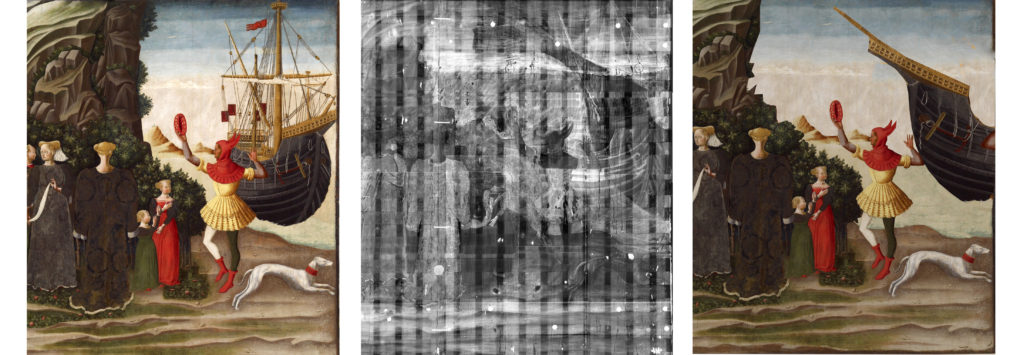
Detail from the Departure showing the painting after conservation (left); the original position of the ship as seen in an x-radiograph detail (center); and a digital re-creation by Hae-Min Park of the initial composition
Incision lines cut into the ground or subsequent design layers with a stylus or compass were another type of preparatory mark used frequently in the Abduction series. Ruled incisions were especially helpful in measuring features of buildings in perspective and are noted in areas of architecture in all three paintings (fig. 18) , in the tiled floors of the Reception and Abduction, and in the ship rigging of the Departure. A compass was used to make rounded incisions in architectural archways, and associated central-point marks can be seen in x-radiographs of all three paintings. A series of points in the statue of Venus and its base in the Abduction corresponds to the oculus and the concentric arches of the temple’s architecture. In the Departure, the incised lines of the circumference and the center points of the arched architecture at left penetrate the painted layer, indicating that a foundation tone of red-orange was first applied for the building, then the architectural detail was incised, and painted in final touches as necessary. Sometimes the incisions for architecture extend into the figures, indicating that the building surrounds were planned first. Freehand incisions were used mainly to indicate pleats and folds in the figures’ garments. These are especially apparent in areas of applied relief brocade, but occasionally also appear in the painted garments as well, including the delineation of legs in the red dress of the female figure to the left of Paris in the Reception (fig. 22).
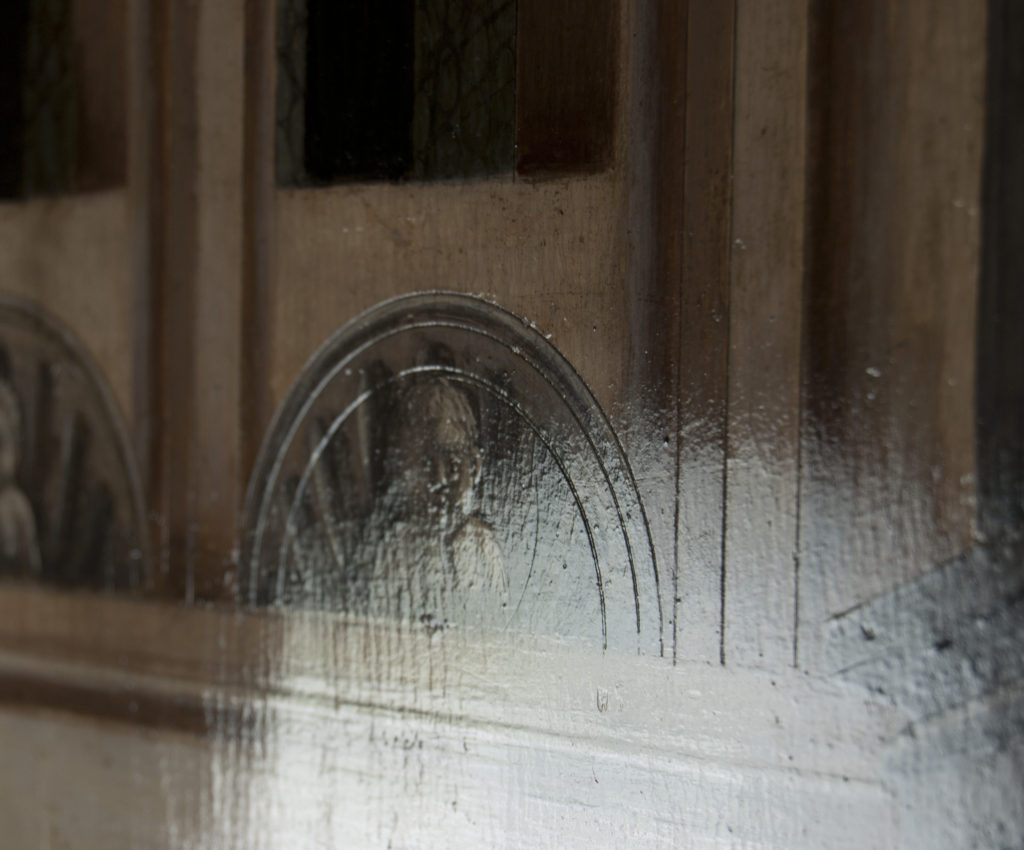
Straight and rounded incisions on architecture in the Reception in reflected light
Linear perspective was used to plan the architecture; the pinprick vanishing points can sometimes be discerned. In the Reception, linear perspective extends throughout the painting, directly correlating with incisions marking out the architectural features (fig. 20); the vanishing point is located on the central figure staring out at the viewer just above the kneeling Helen. In the Abduction, linear perspective was used for the floor and arched ceiling of the Temple of Venus, the vanishing point located in the center of the white sculpture. Although the orientation of the orthogonal incised lines indicate that linear perspective was used, no vanishing point was noted in the Departure.

One-point perspective and extensive incision work in architecture on the Reception, schematics by Lauren Bradley.
Paint Layers
Venice’s position as a major port city and trading center gave artists in the surrounding area access to a wide array of materials, including imported pigments, as demonstrated in these paintings. The palette includes such pigments as azurite, malachite, vermillion, lead tin yellow, red lake from an insect source, verdigris, indigo, lead white, red, yellow and brown earths, carbon black, red lead, and gold leaf (table 1).
Table 1. Analysis of Pigments from Two Paintings in the Abduction Series
| Pigment | Analysis | |||||
| XRFa | Ramanb | FTIRb | SEM-EDSa | FORSb | ToF-SIMSb | |
| Azurite | copper | copper | × | |||
| Carbon black | –c | |||||
| Gold leaf | gold | |||||
| Indigo | –c | × | × | |||
| Iron earths (red, brown, yellow) | iron silicon | iron silicon | × | |||
| Lead tin yellow | tin | |||||
| Lead white | lead | lead | × | × | ||
| Malachite | copper | × | copper | × | × | |
| Red laked | –c | × | ||||
| Red lead | lead | × | ||||
| Verdigris | copper | × | ||||
| Vermilion | mercury | × | ||||
a. Paintings analyzed: Reception and Abduction; with elements of significance noted
b. Painting analyzed: Abduction; confirmation by spectral match to known material
c. No elements of significance detected; low density materials suggested
d. Insect source
Indigo was used extensively as a chromatic background for the foliage in the Departure and the Abduction, as well as for the final presentation surface in the sky of all the paintings, and it was probably mixed with red lake to create the lavender garments on some figures. Indigo was also identified on the associated panel in Melbourne,[26] as well as on several contemporary Venetian paintings, including two from the workshop of Antonio Vivarini and Giovanni d’Alemagna: The Enthroned Madonna and Child with Angels and the Church Fathers Jerome, Gregory, Ambrose and Augustine in the Venice Accademia;[27] and in one of two wings from the altarpiece Saints Francis and Mark at the National Gallery, London, where it is also seen in a polyptych by Giovanni Schiavone;[28] and in an altarpiece by Giovanni Bellini.[29] Barbara Berrie, head of scientific research at the National Gallery of Art, Washington, and an authority on Venetian painting technique, noted that while earlier uses are seen in manuscript painting, the use of certain pigments such as indigo and verdigris in tempera and oil painting is first observed in the second half of the fifteenth century, primarily in Venice and Ferrara.[30] Using these pigments initially in a limited capacity, Venetian artists began “to employ them in quantity” by the last quarter of the century, coinciding with the presumed date of the Abduction series.[31] Venice imported large quantities of tropical Indian-sourced indigo from Baghdad, whereas importation of the pigment was prohibited in other regions of Italy to protect the domestic woad (guado in Italian).[32] Although imported and domestic indigo are indistinguishable under analysis, artists from the Veneto, including those of the Abduction series, were more likely to use the imported indigo, as its color and tint strength were superior to those of the domestic product.[33]
The malachite used in the foliage and green garments is composed of two differently shaped particles: spherical and angular, the latter exhibiting a deeper tonality due to the differences in morphology (see fig. 6).[34] Though the spherical particles could have been prepared synthetically, (from by-products of jeweler’s craft that produced the pigment verditer), they were almost surely formed naturally as a copper by-product of silver mines slowly “growing” the green pigment in highly carbonic spring water. The large particles observed, some in excess of 20 microns, are consistent with naturally occurring particles, whereas the synthetic pigment, produced by the rapid precipitation of a copper nitrate solution with chalk, yielding particles 1–5 microns in diameter, was not observed.[35] Additionally, analysis with SEM-EDS of a cross section from the Abduction revealed significant amounts of silicate, which is associated with the formation of a naturally precipitated pigment.[36] This naturally occurring spherical malachite might have been gathered and imported from the well-known ore-mining center in the Neusohl region in present-day Slovakia.[37] Spherical and angular particles of malachite were also identified on the associated Garden panel in Melbourne.[38]
Several different types of analyses identified the paint medium as egg tempera, including fiber optic reflectance spectroscopy (FORS),[39] time-of-flight secondary ion mass spectrometry (ToF-SIMS),[40] Fourier-transform infrared spectroscopy (FTIR),[41] and gas chromatography–mass spectrometry (GCMS).[42] An examination of the paintings in the 1970s presumed that the paint media was egg tempera mixed with drying oil, but recent analysis detected no trace of drying oil as a paint binder.[43] This finding is significant as the late fifteenth century was a period of transition in Italy: the preference for egg tempera paint binders yielded to oil media; some artists incorporated both media in the same painting. Although not used as a paint binder, oil was present and served a specific purpose in some of the applied ornament, including gilding and applied relief brocade.
The paint was applied in moderately thin layers that exhibit the enamel-like flatness associated with egg tempera surfaces, except for the individualized small raised mounds of paint in the leaves of foliage.[44] In areas of flesh and in the localized shadows of some architecture, the egg tempera was applied in a traditional hatched manner with small parallel brush strokes. Conversely, the paint was broadly brushed in the skies, landscape grounds and marble floor, garments, and undercolor of architecture, perhaps extended with water to allow larger expanses to be brushed across the surface. In foregrounds and architecture, broadly applied scumbles of lighter colors often were applied over darker layers.
The skies are composed of several horizontal bands of blue, appearing almost white at the horizon, with each successive band becoming darker as it approaches the top of the sky (fig. 21). Analysis indicates the use of varying amounts of lead white with indigo to create these graduated tones, with the darkest band of indigo and lead white at the top of each sky enhanced with a glaze of azurite. In a cross-section sample from the darkest blue sky in the Abduction, the overlying coarsely ground copper blue pigments along the top of the painting contained large orange (iron oxide) inclusions, and barium sulfate (associated with azurite) was identified with SEM-EDS.[45] Though the lowest band of sky in each painting now appears white, the passages might have been a very light blue now faded;[46] higher quantities of lead in proportion to indigo can make the indigo more susceptible to fading.[47]
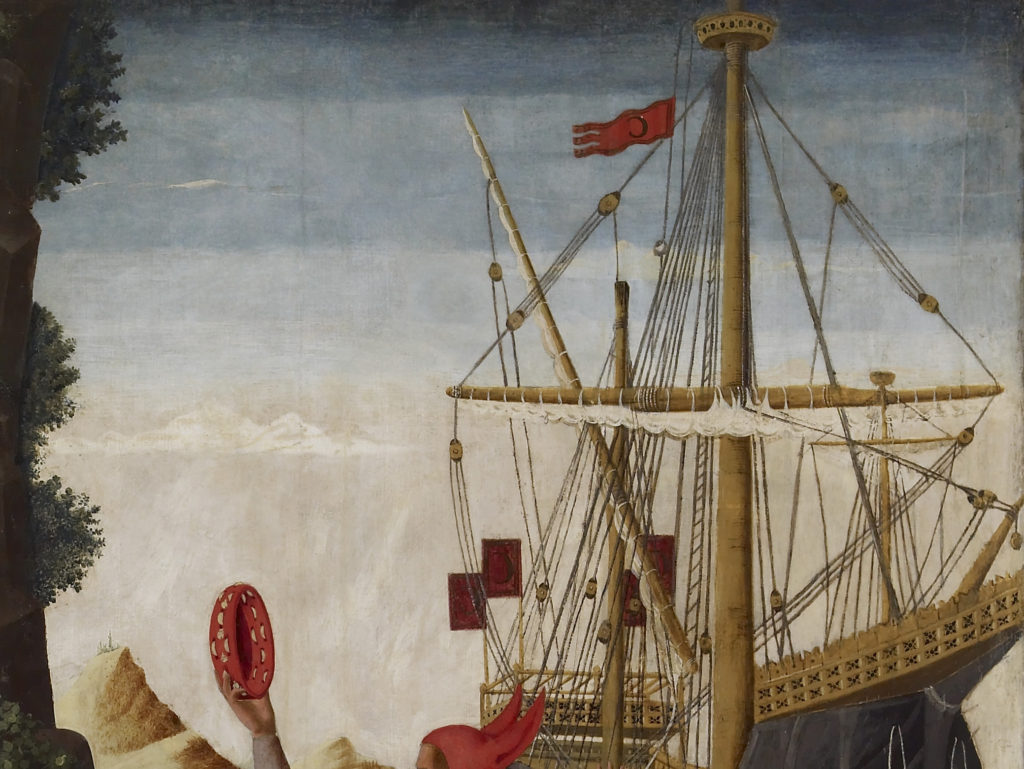
Detail from the Departure, showing graduated bands of blue color in the sky.
Generally, the painting of the sky, foliage, and landscape in the Abduction series proceeded while the figures and large masses of architecture were completed last, allowing for many adjustments during the painting process. While laying out the sky, several large triangular shapes roughly approximating the forms of the foliage were left in reserve (fig. 22). This same method of blocking in the foliage appears in the associated panels: the Garden (fig. 23) and a Hedge of Roses (private collection).[48] These triangular shapes were hidden under subsequent paint layers, creating a more refined silhouette of small leaves against sky. The patterning of the leaves, sometimes radiating in circles, is most clearly visible under IRR, since the underlying indigo becomes increasingly transparent at specific wavelengths in the near-infrared region of the electromagnetic spectrum (fig. 24).
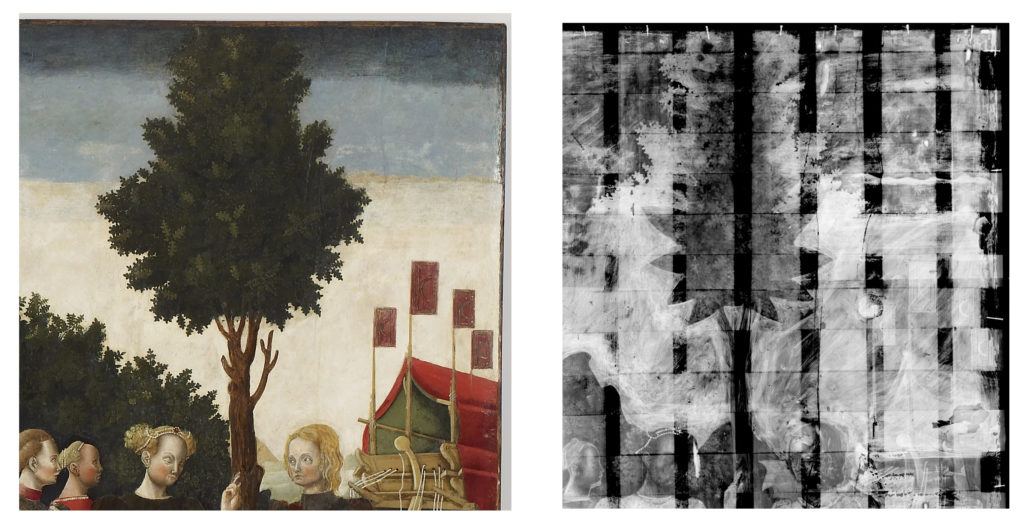
Detail from the Departure in visible light (left) and x-radiograph (right)
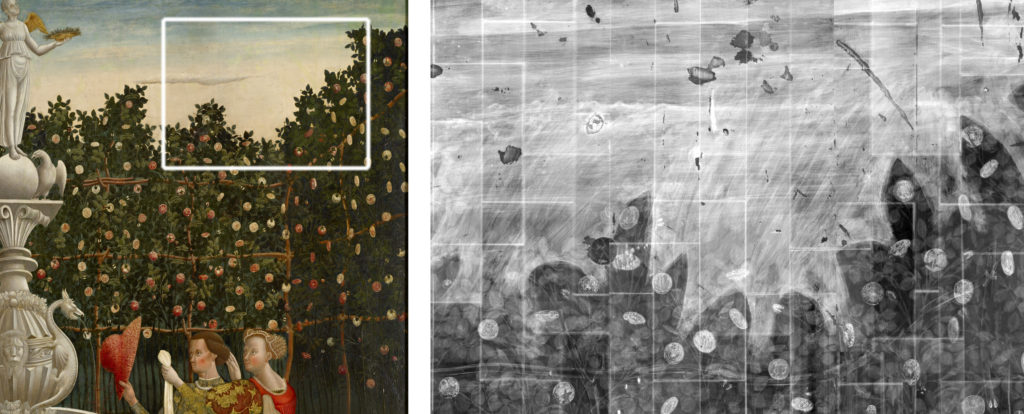
Detail from The Garden of Love, and an x- radiograph detail from the area in the white rectangle showing basic blocking-in of foliage

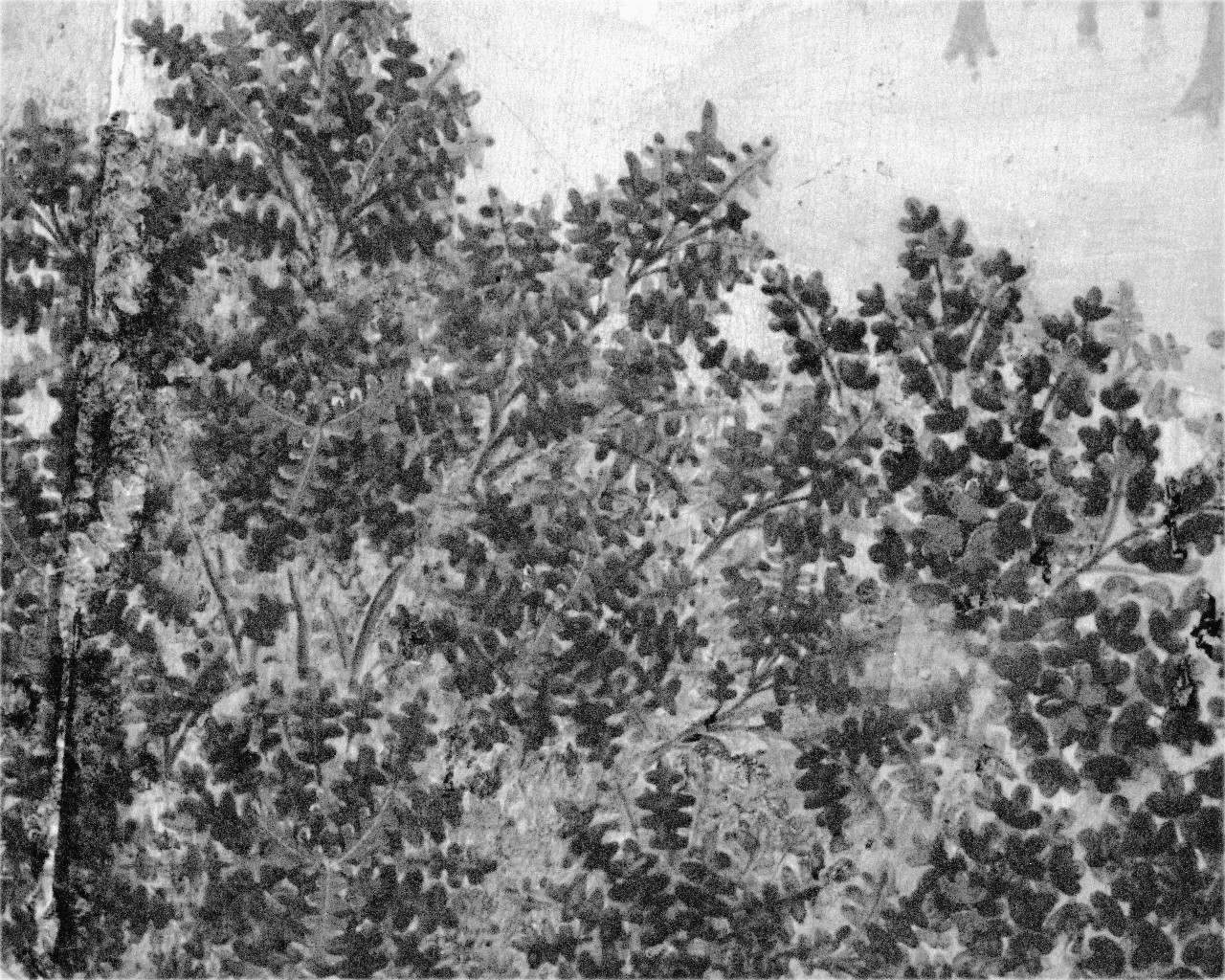
Detail from the Abduction showing the application of leaves, sometimes in circular patterns, in visible light and in infrared.
Cross sections of the foliage from the Abduction show thin underlayers of blue (indigo with lead white) and thicker mixtures of green and other pigments used to form the leaves, sometimes in doubled alternating layers (see fig. 6). Drips of the blue paint from the underlying indigo layer run down the surface of the painting by the tall tree in the Abduction, indicating the fluidity of the media associated with the indigo mixture on application. The thin layers of indigo and lead white also contained calcium and a small quantity of iron, likely residual salts from the indigo plant or additions made during processing of the pigment.[49] The raised texture of the green leaves of the foliage in the Abduction series is highly distinctive; the pigments comprise spherical and angular malachite, verdigris, lead tin yellow, yellow earths, and lead white.[50] Analysis with TOF-SIMS of a cross section with alternating double layers of blue and green revealed proportionally more verdigris than malachite in the bottom darker green layer, which was reversed in the top lighter green layer. These two green pigments, verdigris and malachite, were probably selected for their cool and warm tonalities, respectively.
In both the Departure and the Abduction, the landscapes terminate at far right with a beach beside a waiting ship. A whimsical detail was added to the beaches to give them texture. On both beaches splatters of paint, presumably from the flicking of paint-laden brushes, were added to a sand-colored base paint: white splatters on the Departure and black splatters on the Abduction. The intent was likely to suggest a white sand beach and a beach with black pebbles or volcanic ash. While the paint splatters on the Departure are probably lead based, the black spots on the Abduction were found to have high concentrations of iron, possibly from black pigments mixed with iron earths in egg tempera or possibly iron gall ink mixed with egg tempera.
An especially interesting feature of the Abduction series is a specialized technique used to imitate luxurious gold and silver brocaded textiles on the garments of the figures. Instead of being directly painted, the brocades were constructed with separately made composite materials, primarily with molded tin, applied to the surface of the painting. This technique known as Pressbrokat was popular throughout Western Europe but was rarely used in Italy (Pamela Betts and Glenn Gates, “Dressed in Tin,” in this volume). The molded tin was backed with an oil-based fill mass with red lead pigments and a little resin to help preserve the form and provide a flat surface to glue it to the surface of the painting. Brocades imitating silver were left with the tin untoned; those imitating gold were coated with a transparent yellow paint; both were painted red or blue in selective areas in designs to resemble voided velvet textiles. Although altered by time, the rich textured surfaces survive and give the viewer an impression of the original woven appearance of the textiles.
Conclusions
Collaborative multidisciplinary scholarship informed our understanding and increased our appreciation of these unique and magnificent paintings. The expanded knowledge from the analysis of the materials and techniques of the Abduction of Helen series provided the corroboration necessary for the curatorial research to establish their origins and attribution. Material and structural comparison of the Walters paintings with the two related Garden of Love panels confirmed links from their point of origin and their histories as they aged and underwent restorations. Along with consideration of the materials used to create the painted image, as stated in the preface to Marette’s study, “the importance of the support to the painting as a historical document” should be recognized. The selection of indigenous spruce wood from the north Italian regions; the copious use of indigo; and the extensive use of applied relief brocades found only rarely in the Italian north, all aided Joaneath Spicer (see essay in this journal) in confirming the genesis of these fifteenth century paintings as Venice, or the surrounding Veneto region; the home city of Catarina Corner, for whose wedding these spalliere were likely commissioned.
This project has benefited from the generous contributions of many colleagues. We are grateful to Megan Berkey, Lauren Bradley, Kristin DeGhetaldi, John Delaney, Kathryn Dooley, Gwen Manthey, Michael Palmer, John Payne, Bradley Scates, and Zachary Voras.
[1] Pressbrokat, or applied relief brocade, is a decorative composite technique used to simulate luxury textiles. Tin foil is pressed into an incised mold, coated on the reverse to save the impression, and applied onto an artwork to give dimensional texture in imitation of a brocaded textile.
[2] The Center for Wood Anatomy Research Wood Identification Service at the United States Department of Agriculture recently identified the wood used as the support for the Abduction and the Reception as Picea cf. abies, known as Norway spruce. An old but undated note in the treatment file for the Departure (acc. no. 37.1179) records that the wood was analyzed and found to be spruce, but it does not record the method and place of analysis: since Federico Zeri cited the panels as spruce in his 1976 catalog of the Walters’ Italian collection (1:241), it was likely part of a wood identification campaign undertaken in the 1970s for this catalog.
[3] See Katalog der Gemäldegalerie, Kunsthistorisches Museum Wien, 1: Italiener, Spanier, Franzosen, Engländer (Vienna, 1965), 129–31.
[4] For references to the use of spruce as a painting support in Italy, see Joyce Plesters, “Tintoretto’s Paintings in the National Gallery,” National Gallery Technical Bulletin 8 (1984): 27 (“The identification of the wood as spruce [Picea sp.] is consistent with their being of Venetian/Veneto origin. The majority of Italian panel paintings are on poplar. Spruce has rather rarely been identified except in Venetian/Veneto works”); Peter Klein and J. Bauch, “Analyses of Wood from Italian Paintings with Special Reference to Raphael,” The Princeton Raphael Symposium: Science in the Service of Art History, ed. John Shearman and Marcia B. Hall (Princeton, 1990), 85–92; Raffaella Bruzzone and Maria Clelia Galassi,“Wood Species in Italian Panel Paintings of the Fifteenth and Sixteenth Centuries: Historical Investigation and Microscopical Wood Identification,” in Studying Old Master Painting: Technology and Practice, ed. Marika Spring (London, 2011), 255–56. (“Spruce . . . can be considered as a wood typical of the Venetian School”). Citing Marette’s studies of more than a thousand panel paintings from the twelfth to sixteenth centuries (see below, note 5), Ciro Castelli noted that “poplar was the species of wood used in Italy in 90% of the cases examined, while the rest of the total is divided among 2% lime, 3% silver fir, 1% spruce, 3% walnut, and 1% oak.” Ciro Castelli, “Techniques of Construction of Wood Supports for Painting,” in Marco Ciatti et al., Panel Painting: Technique and Conservation of Wood Supports (Florence, 2006), 84.
[5] Jacquelline Marette, Connaissance des primitifs par l’étude du bois du XIIe au XVIe siècle (Paris, 1961), 62, 73, trans. Paul van Claster as Wooden Supports in Twelfth–Sixteenth-Century European Paintings (London, 2015).
[6] For the role of guilds, see Castelli, “Techniques of Construction of Wood Supports for Painting,” 85.
[7] A “cheese” glue could be applied at room temperature, had a slow drying time, and resulted in a strong bond. See Cennino Cennini, Il libro dell’arte, trans. Lara Broecke (London, 2015), chap. 111, p. 145.
[8]Dowels were often constructed of a harder wood than the painting support: spaced along the length and across the joins to reinforce them. They were made a little shorter than the channel constructed for them, slid into the slot but not glued.
[9] See Karen French and Eric Gordon, “Conservation,” in this volume.
[10] X-radiography was performed in-house on the Abduction using a Phillips tube and a digital phosphor plate. X-radiography of the Reception and the Departure was undertaken by the outside firm MQC Labs Inc. (Aberdeen, Maryland), using film.
[11] For the number of boards and panel sizes, see Marette, Connaissance des primitifs par l’étude du bois du XIIe au XVIe siècle, 62, 73, trans. van Claster as Wooden Supports in Twelfth–Sixteenth-Century European Paintings, part 2, chap. 7
[12] Luca Uzielli, “Historical Overview of Panel-making Techniques in Central Italy,” in The Structural Conservation of Panel Painting: Proceedings of a Symposium at the J. Paul Getty Museum, April 24–28, 1995, ed. Kathleen Dardes and Andrea Rothe (Los Angeles, 1998), 116.
[13] Infrared reflectography is a technique that “looks” through paint layers to infrared-absorbing material such as carbon, frequently used in artist’s preliminary drawings. IRR is used to identify underdrawing using a special camera with a detector sensitive in parts of the infrared range; the level of penetration depends on the paint and the length of the wave of infrared radiation.
[14] Uzielli, “Historical Overview of Panel-Making Techniques,” 121–24; Ciro Catelli, “Techniques of Construction of Wood Supports for Painting,” Panel Painting Technique and Conservation of Wood Supports (Florence, 2006),86–87.
[15] John Payne, “Exploring a Fifteenth-Century Garden: A Restoration Uncovers the Past,” Art Bulletin of Victoria 35 (1994): 7–20 at 11.
[16] John Payne, primary report, examination and treatment notes on The Garden of Love (acc. no. 1827/4), National Gallery of Victoria, Melbourne, 1993.
[17] Glue sizing consists of a weak solution of adhesive in water that can be observed as a thin, brightly fluorescing layer in cross-section samples viewed under ultraviolet-excited light. In the Abduction (37.1180), glue can be seen soaked into the wood support in cross-section samples 1a and 2b. Calcium sulfate and protein were detected with time-of-flight secondary ion mass spectrometry (TOF-SIMS) in ground layers of samples 1a and 9, and a faint signal for hydroxyproline (a major component of the protein collagen) in sample 9. Calcium, sulfur, and a few large pieces of silica (probably quartz) were identified in scanning electron microscopy/energy dispersive x-ray spectroscopy (SEM-EDS) in samples 2a and 3; gypsum was indicated with fiber optic reflectance spectroscopy (FORS) in sample sites 1–5. The same findings, with the addition of aluminum, were identified with SEM-EDS on sample 4 from the Reception.
[18] Found with SEM-EDS. Aluminum is seen in greater concentrations in the lower ground in sample 4 of the Reception (37.1180).
[19] Measurements were taken from sample 1a from the Abduction, the only intact complete sample from any of the three panels.
[20] SEM-EDS analysis undertaken with a Hitachi S-3400N variable-pressure scanning electron microscope (VP-SEM) fitted with an Oxford Instruments X-max detector and AZtec X-ray spectrometer. Analysis by Michael Palmer, NGA Scientific Research Department, National Gallery of Art, Washington. Results were communicated during analysis and by email dated September 24, 2014).
[21] The Melbourne Garden panel also has two ground layers; analysis revealed a hydrated form of calcium sulfate, but it is not known which layers were tested. See John Payne, Garden of Love primary report, 6 n. 5: “Debra Lau-Greig has carried out initial thermal analysis on the ground in the Garden of Love and found it to be the hydrated form of calcium sulphate.”
[22] The binder of this layer was not analyzed; it is possibly the same egg tempera used as the binder for the subsequent design layer
[23] See Betts and Gates, “Dressed in Tin,” in this volume.
[24] “Tempera” in its broad sense derives from the verb “to temper,” referring to combining pigments with a medium, but the term is commonly used today to mean pigments mixed in an egg-yolk medium.
[25] Infrared images acquired with a GA 1280JS Sensors Unlimited/Goodrich short-wave infrared camera. Indium gallium arsenide detector, outfitted with a Edmund Optics 50mm SWIR M42 lens.
[26] John Payne, Garden of Love primary report, 48, and file note, acc. no. 1827/4, March 24, 1997, National Gallery of Victoria, Melbourne. The finding was based on the elimination of other possibilities with analysis using SEM/EDX.
[27] Giovanna Nepi Sciré, “Prelude to Works in Exhibit,” in Renaissance Venice and the North: Crosscurrents in the Time of Dürer, Bellini, and Titian, ed. Bernard Aikema and Beverly Louis Brown (London, 1999),17. Verdigris was found (analysis by Stefano Volpin).
[28] Margriet Van Eikema Hommes, “Indigo as a Pigment in Oil Painting and Its Fading Problems,” in Changing Pictures: Discoloration in Fifteenth–Seventeenth-Century Oil Paintings, ed. Margriet Van Eikema Hommes (London, 2004), 158 n. 70, citing personal communication with Marika Spring, Scientific Department, National Gallery, London.
[29] Gianluca Poldi and Giovanni Carlo Federico Villa, “A New Examination of Giovanni Bellini’s ‘Pesaro Altarpiece’: Recent Findings and Comparisons with Other Works by Bellini,” in Studying Old Master Paintings: Technology and Practice, ed. Marika Spring (London, 2011),28–36 at 35.
[30] Barbara H. Berrie, “Pigments in Venetian and Islamic Painting,” in Venice and the Islamic World, 828–1797, ed. Stefano Carboni(New York, 2007),140–45 at 145 n. 9.
[31] Berrie, “Pigments in Venetian and Islamic Painting,” 144.
[32] For the importation of indigo into Italy, see Hommes, “Indigo as a Pigment in Oil Painting,” 98. For information on woad, see Louisa C. Matthew, “Working Abroad: Northern Artists in the Venetian Ambient,”in Renaissance Venice and the North, 61–69 at 65, quoting Franco Brunello, Arti e mestieri a Venezia nel Medioevo e nel Rinascimento (Vicenza, 1980) 141 n. 33.
[33] Hommes, “Indigo as a Pigment in Oil Painting,” 100, 104, 115–16, 121.
[34] Noted by Michael Palmer (SEM-EDS), National Gallery of Art, Washington, DC, Scientific Research Department.
[35] For information on naturally occurring spherical malachite, see Gunnar Heydenreich, “A Note on Schifergrün,” Studies in Conservation 48 no. 4 (2003): 227–36; Gunnar Heydenreich et al. “Malachite Pigment of Spherical Particle Form,” in Proceedings of the Triennial Meeting of the ICOM Committee for Conservation, vol. 1 (The Hague, 2005), 480–88. For information on verditer, see Peter MacTaggart and Anne MacTaggart, “Refiner’s Verditer,” Studies in Conservation 25, no.1 (1980): 37–45. To make verditer pigment, a solution of nitric acid in water, called aqua fortis, is used to extract copper from silver and gold, resulting in a solution of copper nitrate that is then poured over chalk, or calcium carbonate, to produce verditer pigment.
[36] Silicate was identified with SEM-EDS National Gallery of Art Scientific Research Department. For additional information see Heydenreich et al., “Malachite Pigment,” 487.
[37] Heydenreich et al., “Malachite Pigment,” 480.
[38] Malachite particles were identified by SEM-EDS.
[39] FORS was conducted by John Delaney and Kathryn Dooley, National Gallery of Art, Washington, DC, in June, 2104; lipid absorption was measured on different sites @ 2302, 2307-2308, 2309, 2310–11, 2347, 2348, 2349–51
[40] ToF-SIMS was conducted by Kristin deGhetaldi, doctoral candidate in Preservation Studies, University of Delaware, and Zachary Voras 2014: palimitic, stearic, protein (CN)
[41] FTIR analysis was conducted by Glenn Gates, Conservation Scientist and Megan Berkey, Samuel H. Kress Paintings Conservation Fellow, Walters Art Museum, Baltimore. Egg protein was suggested by key amide band peak at 1653 cm (-1) / 1647 (-1) and absence of strong carbonyl band at 1740–1710 for oil.
[42] GCMS was conducted by Glenn Gates and Bradley Scates, Walters Art Museum, Baltimore, in August 2014.
[43] For more information on the binding media, see Glenn Gates et al., “Resolving the Mystery of the Paint Binding Media in The Abduction of Helen from Cythera” in this journal.
[44] Gates et al., “Resolving the Mystery of the Paint Binding Media.”
[45] Barium sulphate is a material of paragenesis (mineral association) with azurite. See Nati Salvadó et al., “New Insights on Blue Pigments Used in Fifteenth-Century Paintings by Synchrotron Radiation micro FTIR and XRD,” Analytical Methods 6 (May 2014): 3610.
[46] This area was only examined with XRF, which cannot identify indigo.
[47] Hommes, “Indigo as a Pigment in Oil Painting,” 133.
[48] Payne, “Exploring a Fifteenth-Century Garden,” 13–14.
[49] For iron oxide as a residual salt from the plants, see Hommes, “Indigo as a Pigment in Oil Painting,” 102.
[50] Malachite identified in the foliage with TOF-SIMS (sample 1a), FORS X foliage sites 1–5, seen as copper green in SEM-EDS (sample 2a), FTIR (sample 1a).
